1lumen selects and reviews products personally. We may earn affiliate commissions through our links, which help support our testing.
Lumintop DF11 review
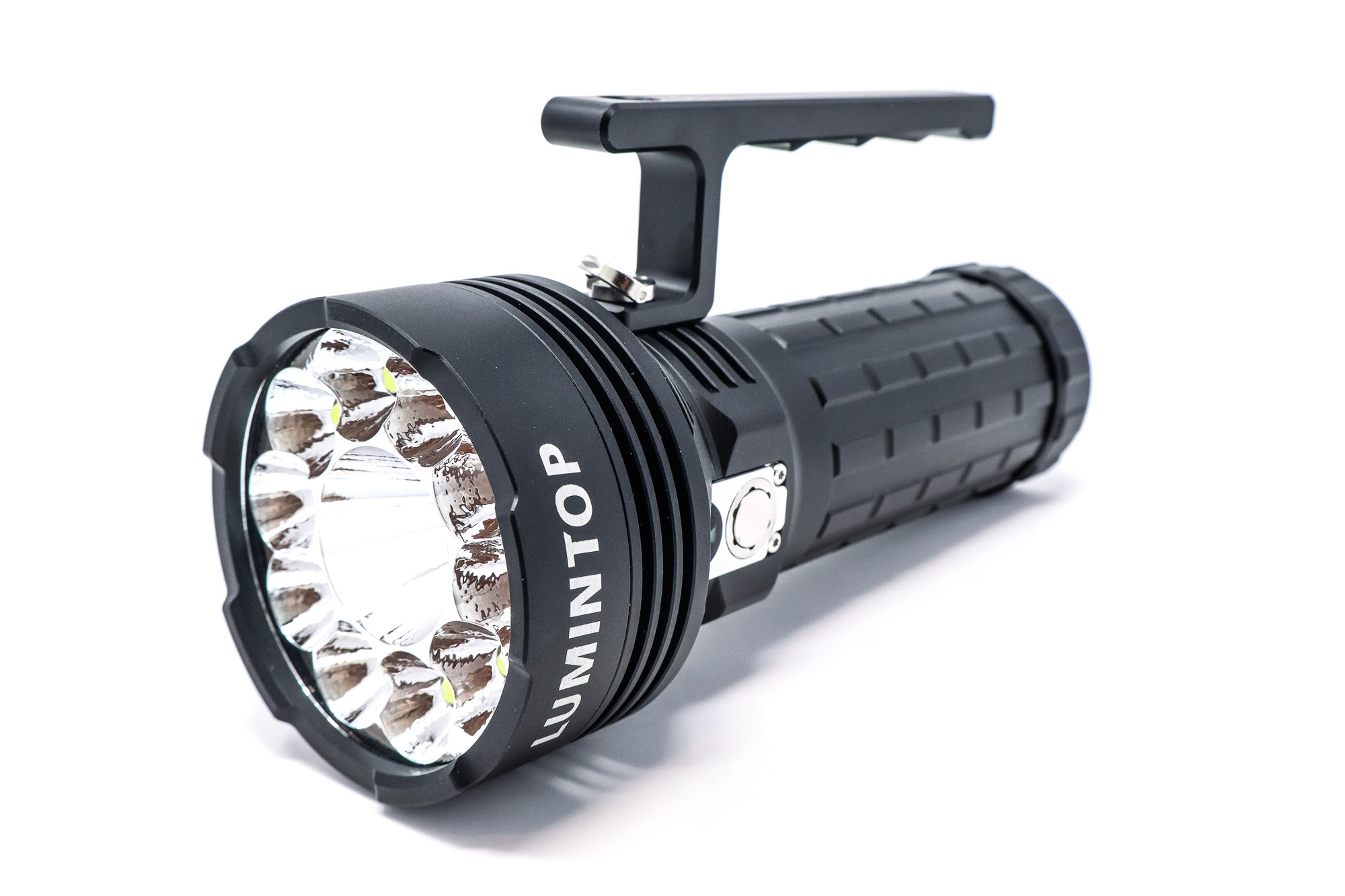
Lumintop DF11 specifications
| Brand & Model | Lumintop DF11 |
|---|---|
| Flashlight category | Lumen monster, searchlight |
| LED | 1x Luminus SFT40 + 10x others (unspecified) |
| Max. output | 26,000 lumens |
| Max. beam distance | 760 meters |
| Max. beam intensity | 145,000 cd |
| Battery config. | 46110 (built-in) |
| Onboard charging | USB-C |
| Main modes | 15 |
| Blinkies | Strobe, SOS, Beacon |
| Waterproof | IP68 |
| Review publication date | March 2024 |
Review intro:
Lumintop has a pretty deep line-up, especially when they notice that a particular product is catching on. They picked up production of the now-famous FW3A and it sold like hotcakes. So what do we have now? About 100 (ok, maybe not but close) iterations of the FW3A in different sizes, materials, emitter choices, and battery configurations. The BLF GT is no different. If it works, make several variations and see what sticks, right? Ok, so Lumintop has us flashlight enthusiasts figured out. Yes, some of us will buy every version of a product.
The new Lumintop DF11 doesn’t seem to be a member of any particular line of flashlights (eg, FW or GT) aside from it being one of their high-output offerings. The DF11 features dual-output (spot+flood), which seems to be all the rage these days. Featuring 26,000 lumens, it definitely means business. And it uses the largest battery I’ve ever seen in a flashlight: a 38,000 mAh 46110 lithium-ion cell (well, aside from the old 6V lantern batteries). On paper, it sure sounds impressive! But can it live up to the hype?
To get started with the Lumintop DF11, make sure to unscrew the head and remove the isolating disc that sits atop the battery.
What’s in the package
The Lumintop DF11 arrives in a large white box that has the familiar Lumintop bunny and branding on the lid, and a magnetic closure on the side. Overall pretty nice, but not flashy. Inside the box is a large hunk of white foam that has been cut out to perfectly hold the DF11 and its accessories. All told, the box contained:
- Lumintop DF11
- Carry handle
- Charging cables
- Manual
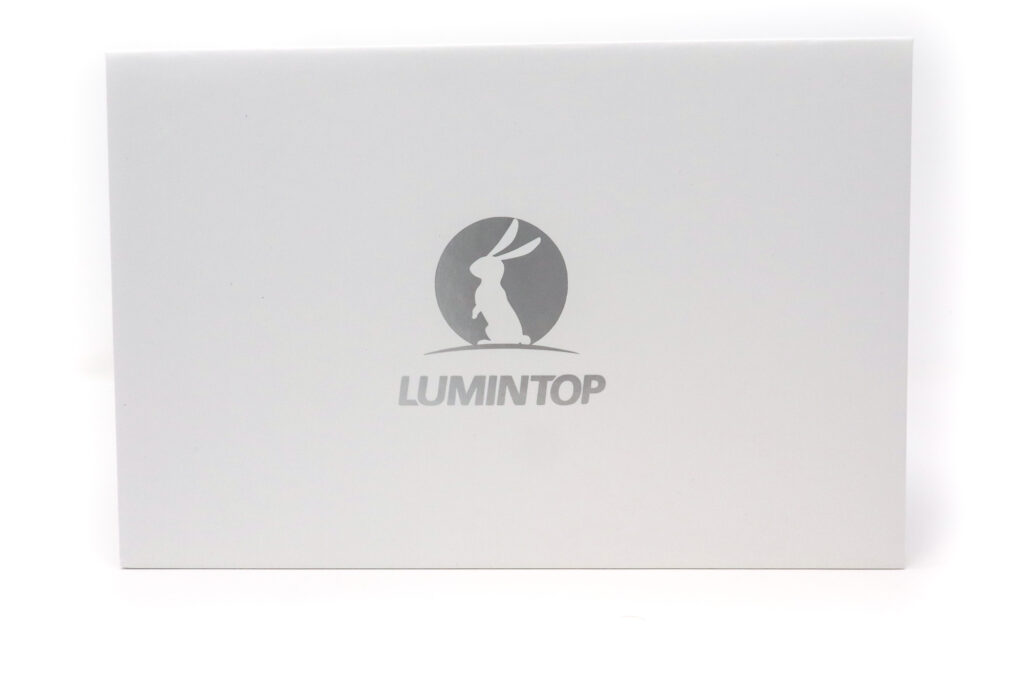
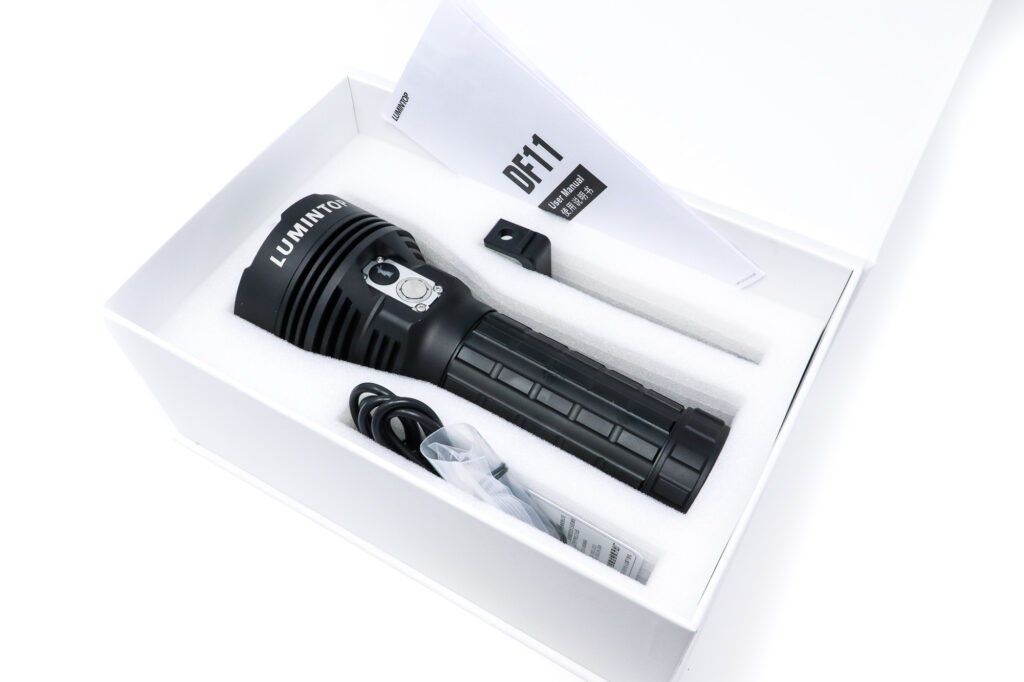
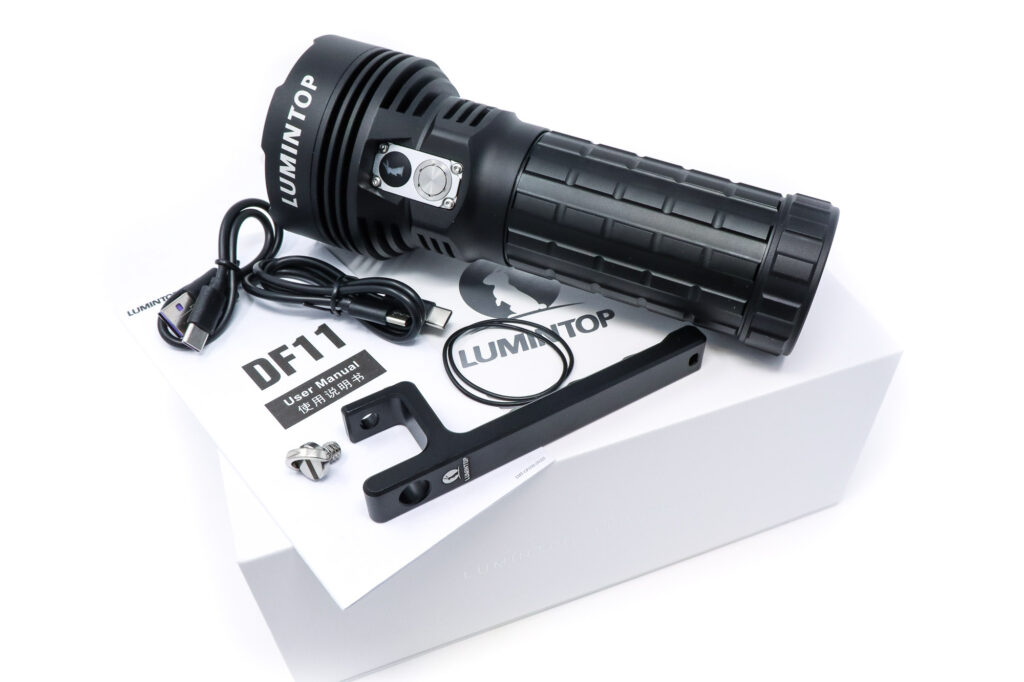
Flashlight in use, Build Quality, and Warranty
When I tested the Fenix LR50R and LR40R v2 lights, I thought those were massive. And they certainly are – but the Lumintop DF11 is even bigger. So it’s a good thing that the DF11 comes with a handle, which might be more comfortable depending on how you plan on using the large Lumintop. The handle does not come pre-installed. Rather, you can use the included bolt to attach it as desired. You do not need any special tools to install the bolt, either, and it has a sort of wire loop attached to it so you can get leverage. Unlike some other flashlight with handles, the DF11 does not look unusual if you choose not to install it – the attachment point is fairly discrete.
As you could guess by how easy the handle is to install and remove, there are no electrics in it. No fans, no switches, etc. Which is a bit of a bummer because a handle-mounted switch is pretty convenient, especially if the body of the flashlight gets hot enough that you might risk getting burned by touching the body to turn off the light. Not to get ahead of myself, but don’t worry about that last aspect – despite touting 26,000 lumens, the DF11 isn’t likely to be burning your hands.
One thing that I didn’t realize until I unboxed the Lumintop DF11 – the battery is built-in. Well, sorta. You can unscrew the battery tube from the head, but the battery is built into the battery tube. So aside from initially removing the battery protection disc, there’s never a reason to unscrew the battery from the head.
As far as switches go, you get two of them. They’re both e-switches, positioned on the head of the flashlight, with one over top of the other. The top switch has a mostly-black silicone cover with a clear area in the middle in the shape of the Lumintop mascot. That top switch controls on/off and modes – the normal functions of a flashlight. The second switch has a metal button cover and is used solely for switching between output channels (spot, flood, or both).
At first I was confused by how I was supposed to know which output channel was active, and then I read the manual and realized that the indicator LEDs under the bunny logo were actually a read-out to let you know what channel(s) were active: green is flood, blue is spot, and blue + green is (you guessed it!) flood + spot. You can change the output channels regardless if the flashlight is off or on and still get feedback on what is active. My moment of frustration turned to an “oh, that’s clever” and actually a point of positivity about the DF11.
Lumintop says that the DF11 is ideal for search and rescue, hiking, camping, etc. I’m going to have to disagree. I hate to reveal the performance this early on in the review, but unless your search and rescue operations only ever last 30 seconds, you’re going to want a different flashlight. And with hiking, you generally want to pack fairly light if you’ll be hiking any sort of distance. With this beast clocking in at over 1 kg (2.4 lbs), this flashlight might be heavier than you’re willing to haul. Camping? Now that is a use I can get behind. That’s because the DF11 excels at really long runtimes due to that massive 38,000 mAh battery. And it can be used as a power bank, so you’ll be able to use it to power up your phone or portable flashlight.
Warranty:
- 30 days of purchase: Free repair or replacement with manufacturing defects.
- 5 years of purchase: Lumintop will repair the products free of charge within 5 years of purchase (products with built-in battery 2 years, battery 1 year) if problems develop with normal use.
- Lifetime warranty: If repair is required after the guaranty period, we’ll charge for parts accordingly.
- This warranty does not cover normal wear and tear, improper maintenance, abuse, force majeure damage, or defaults by human factors.
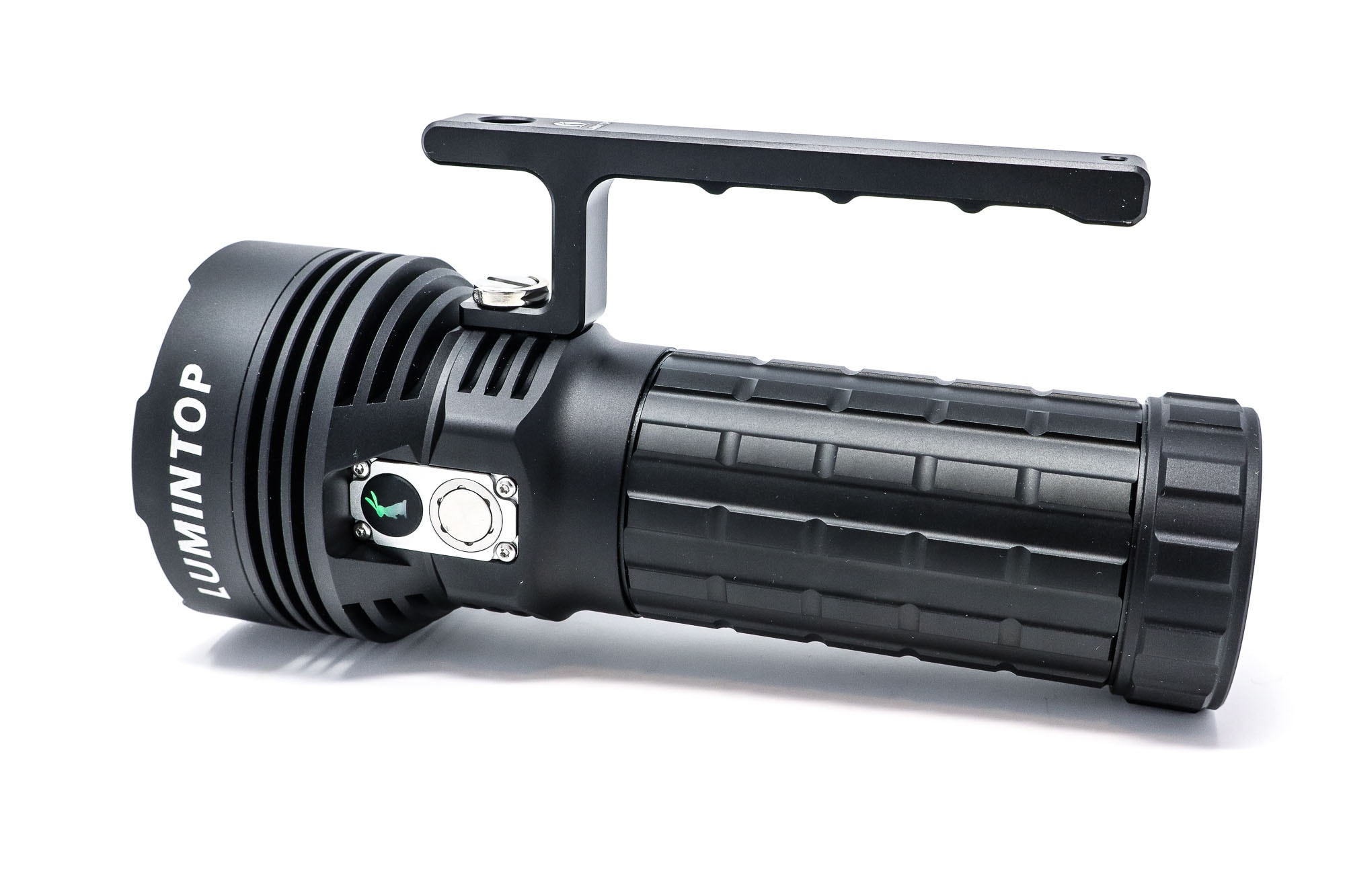
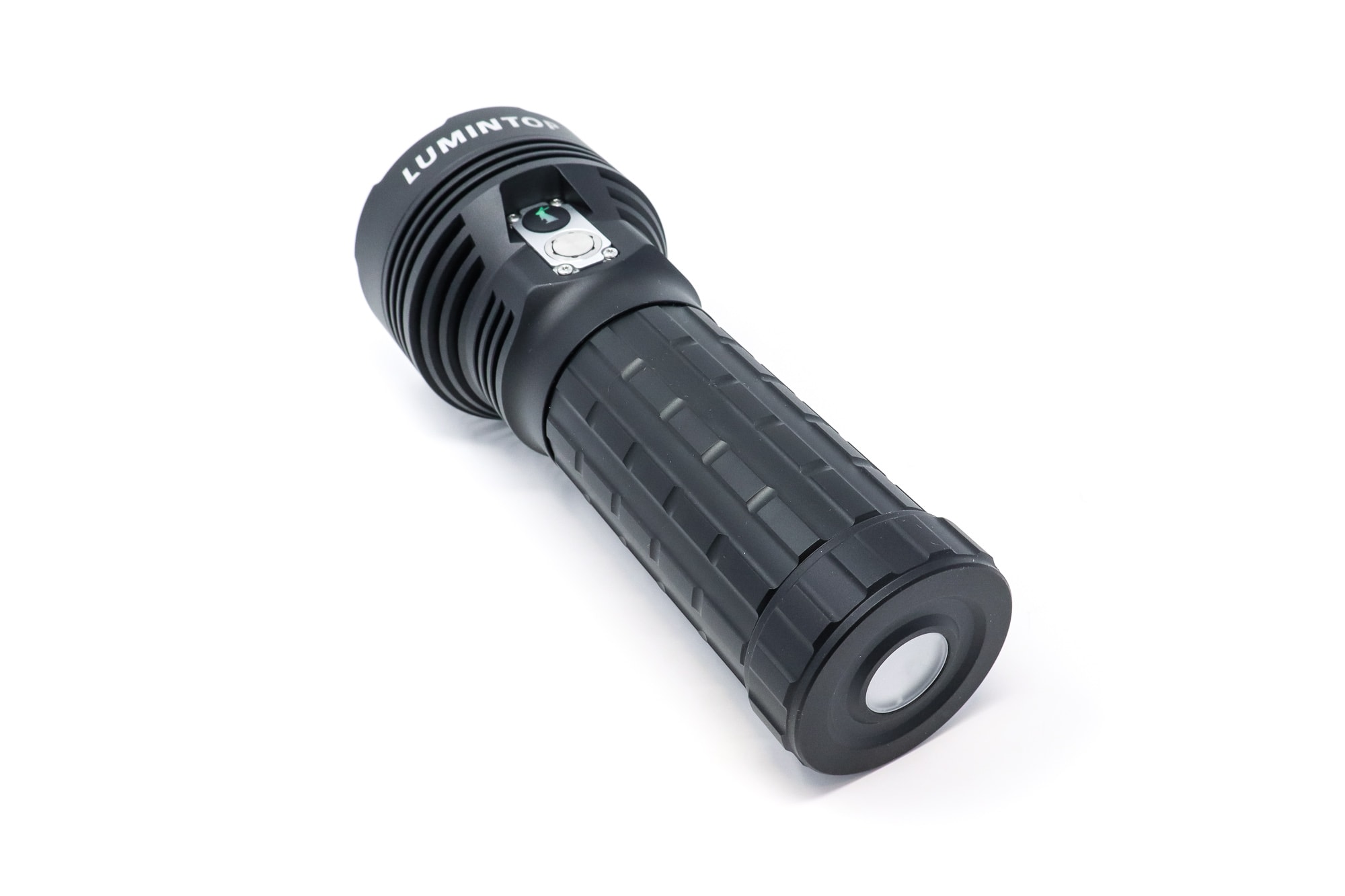
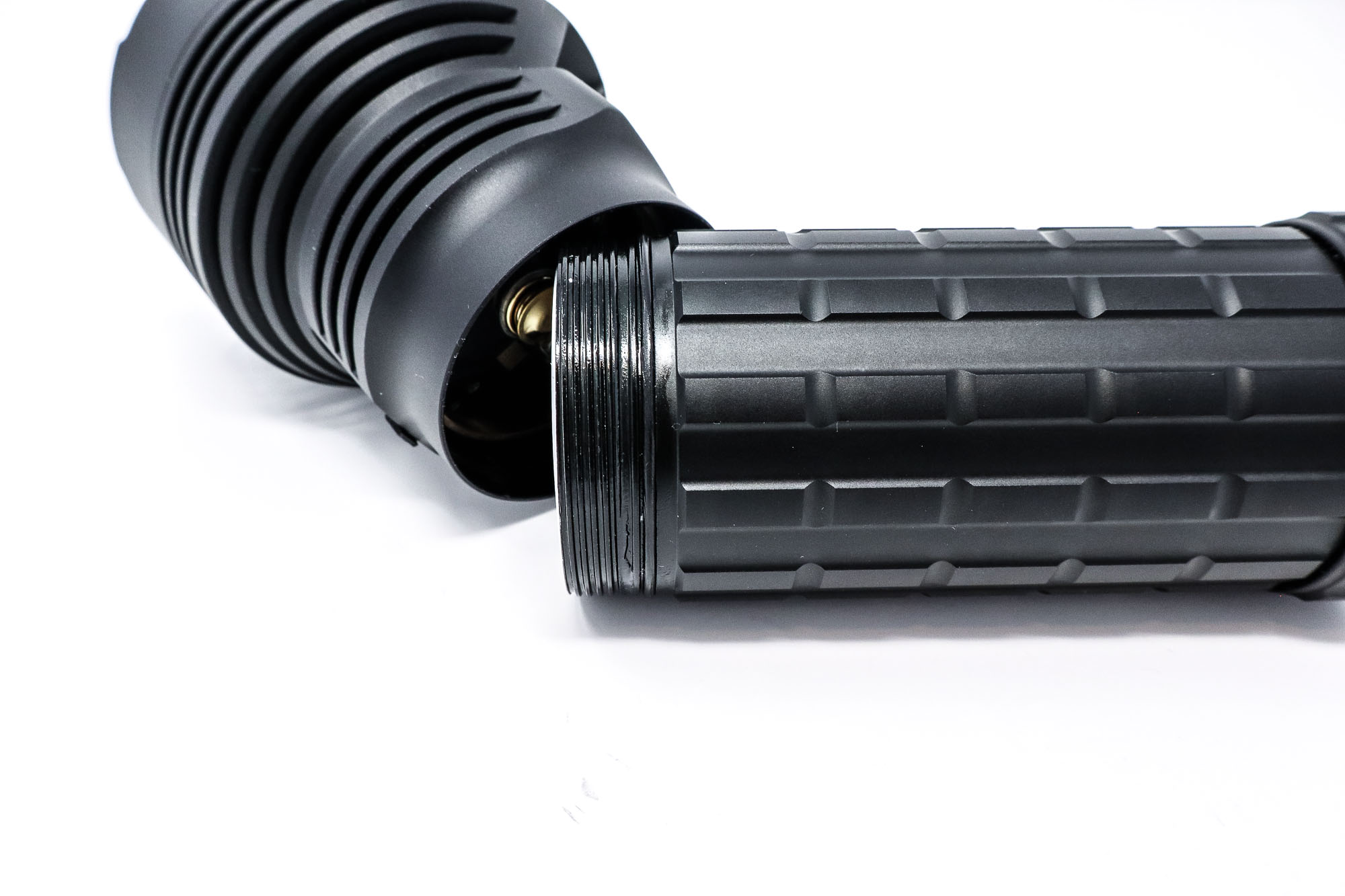
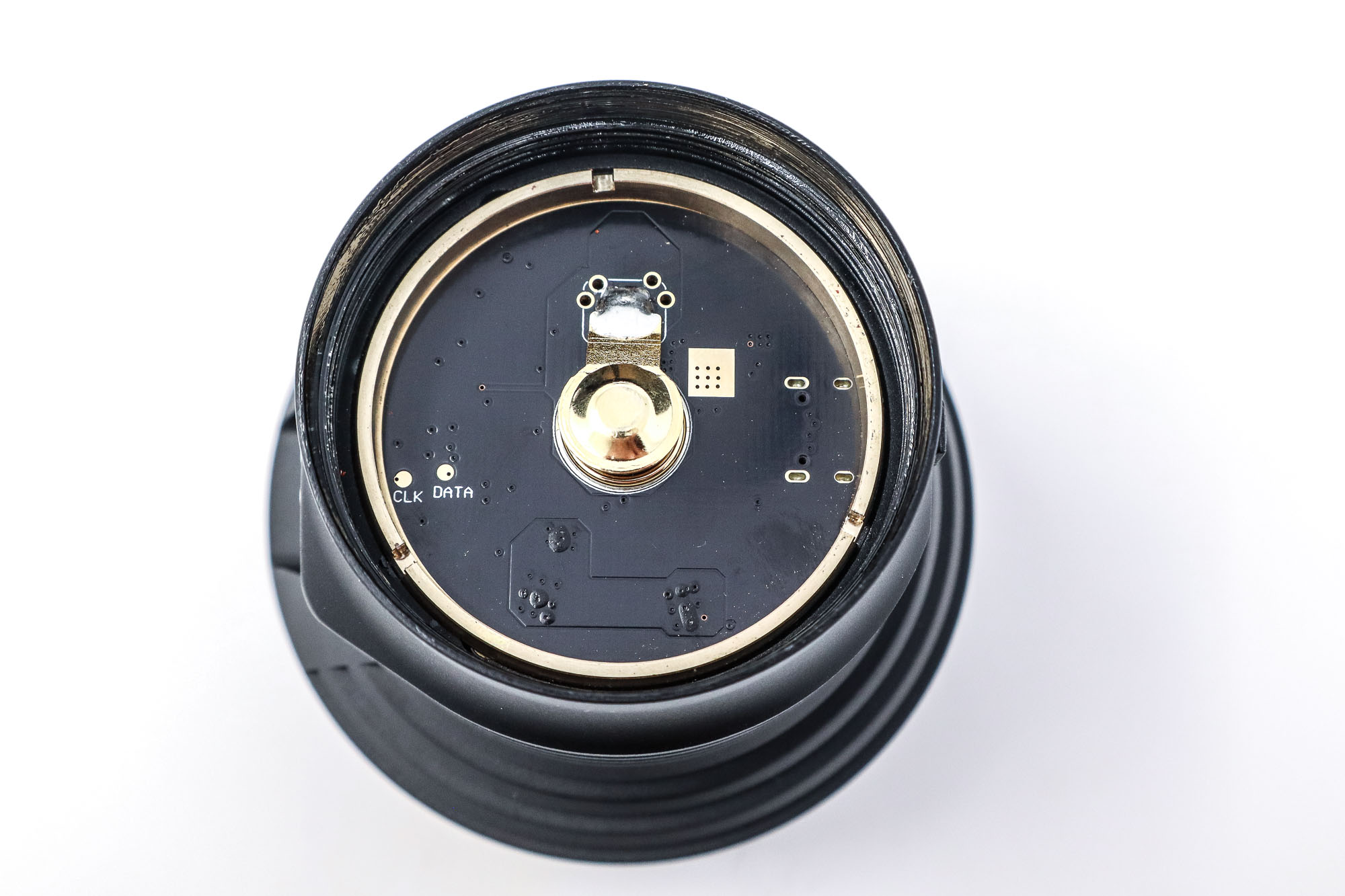
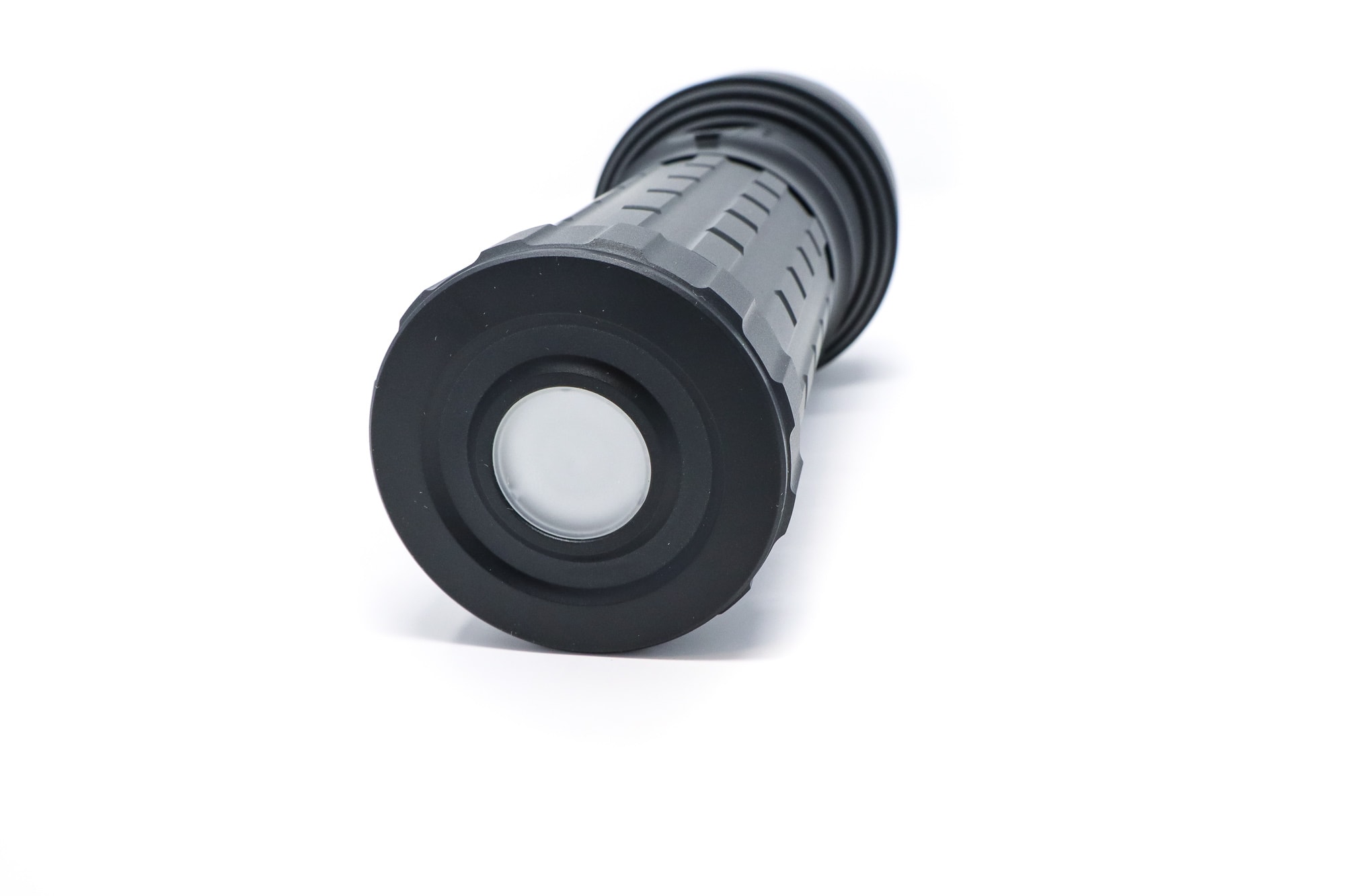
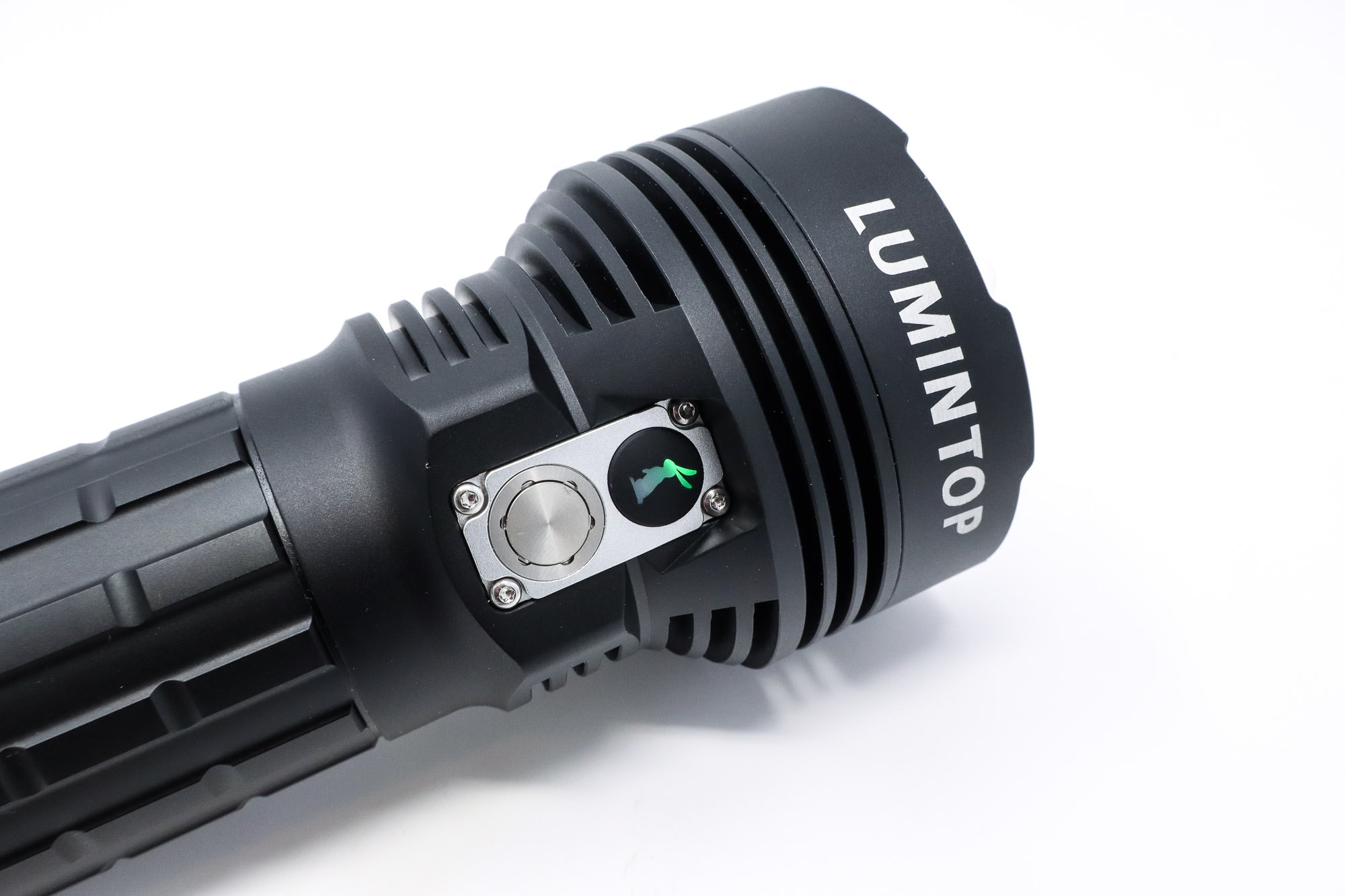
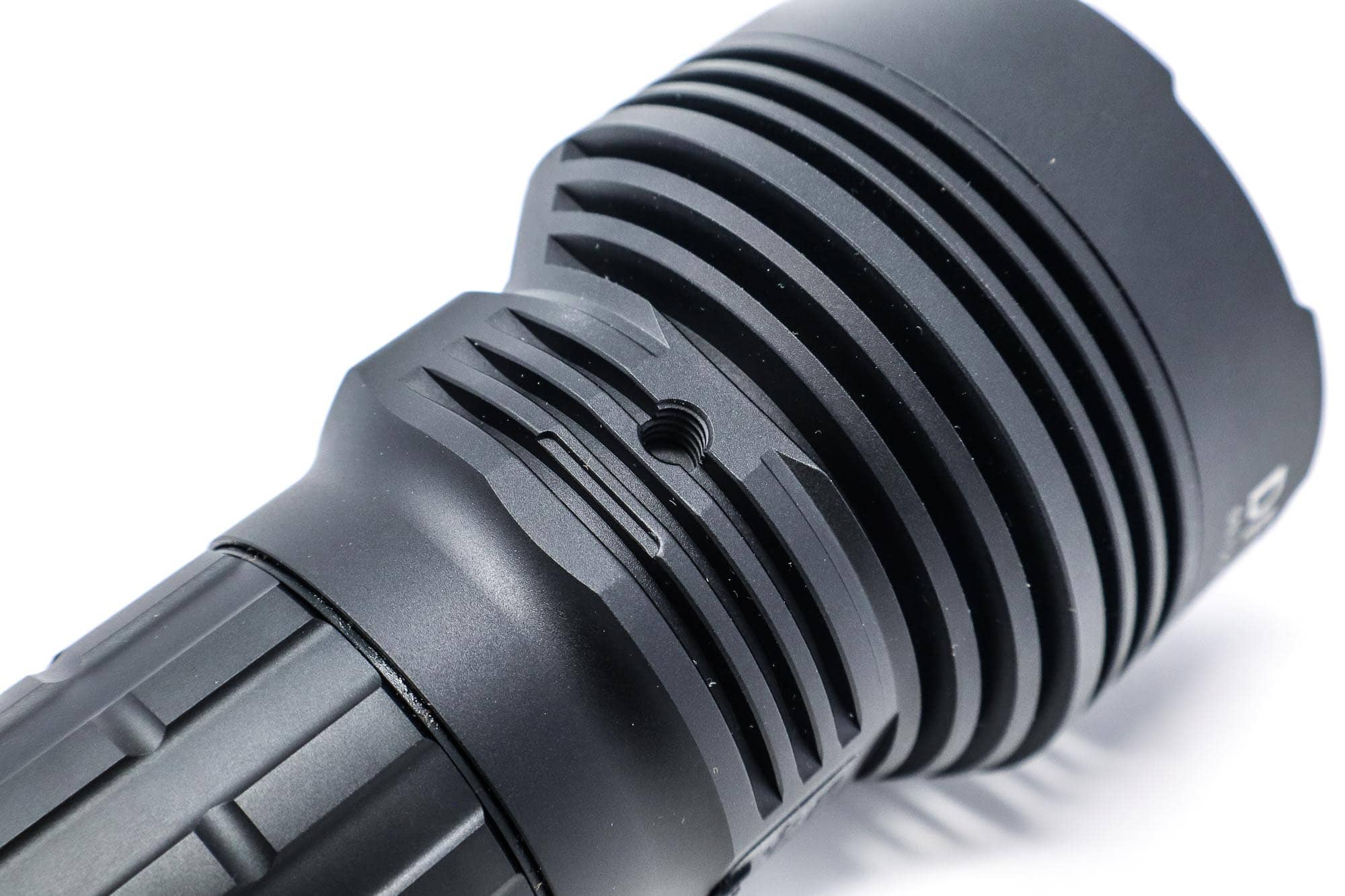
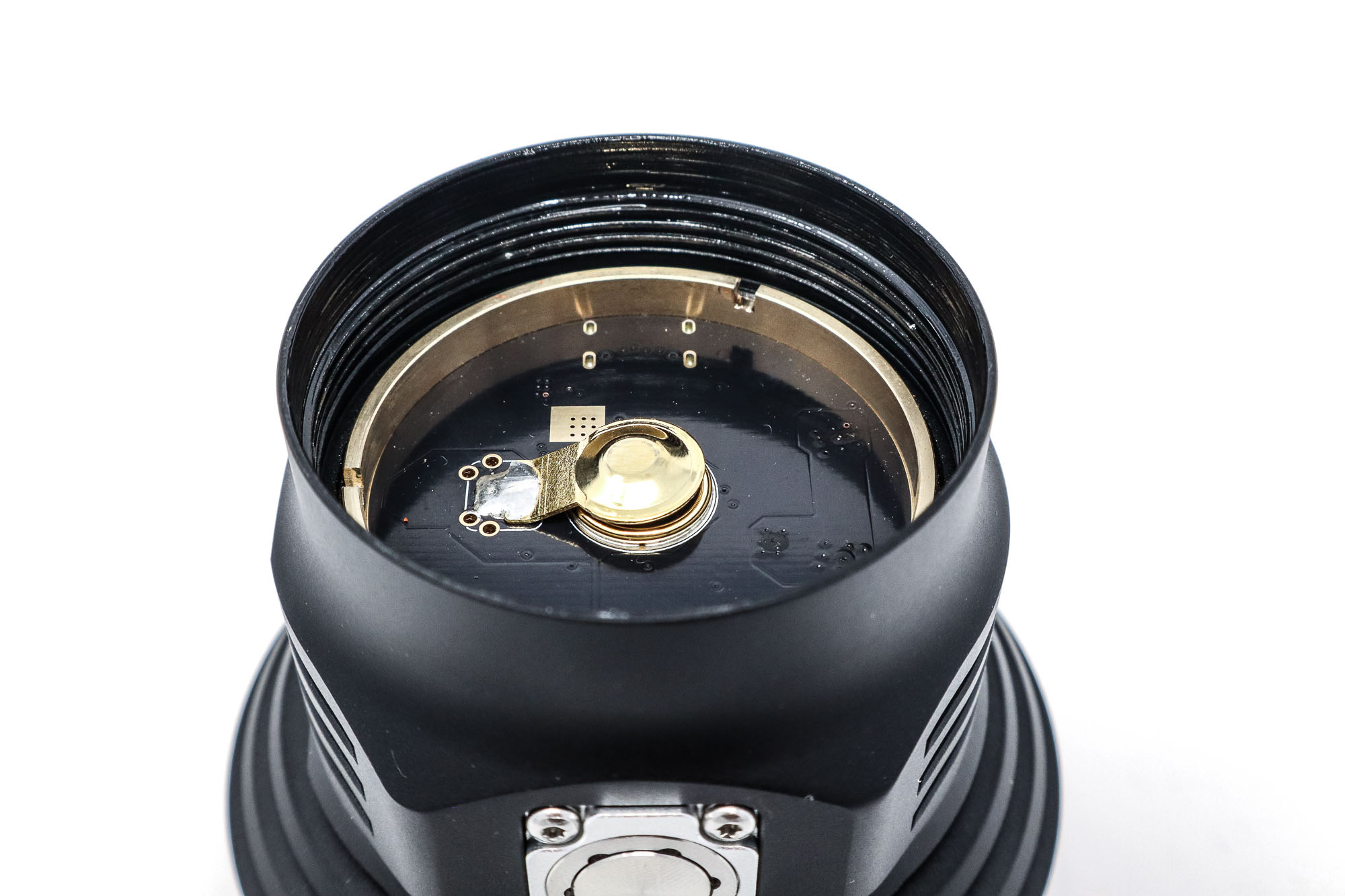
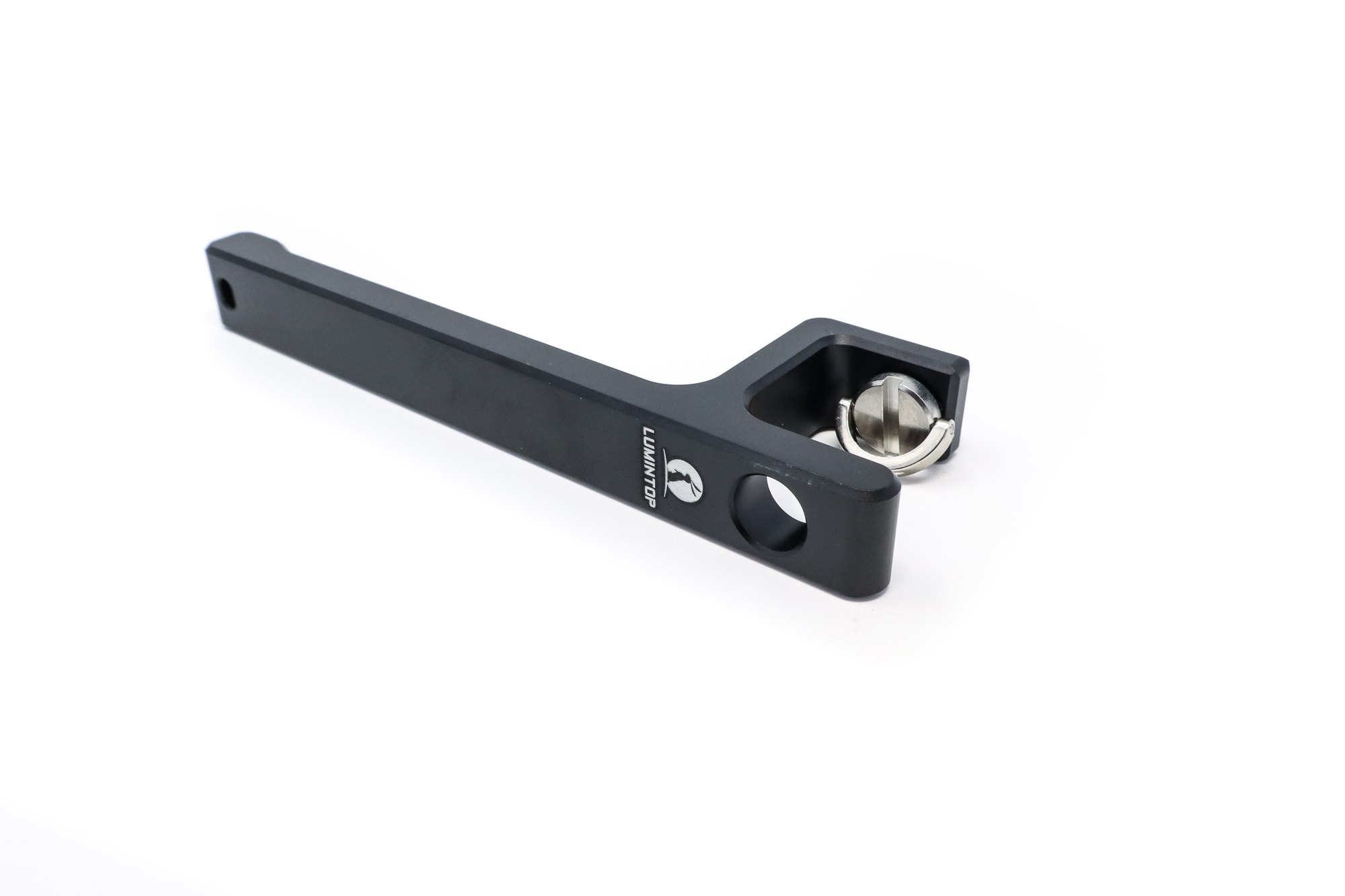
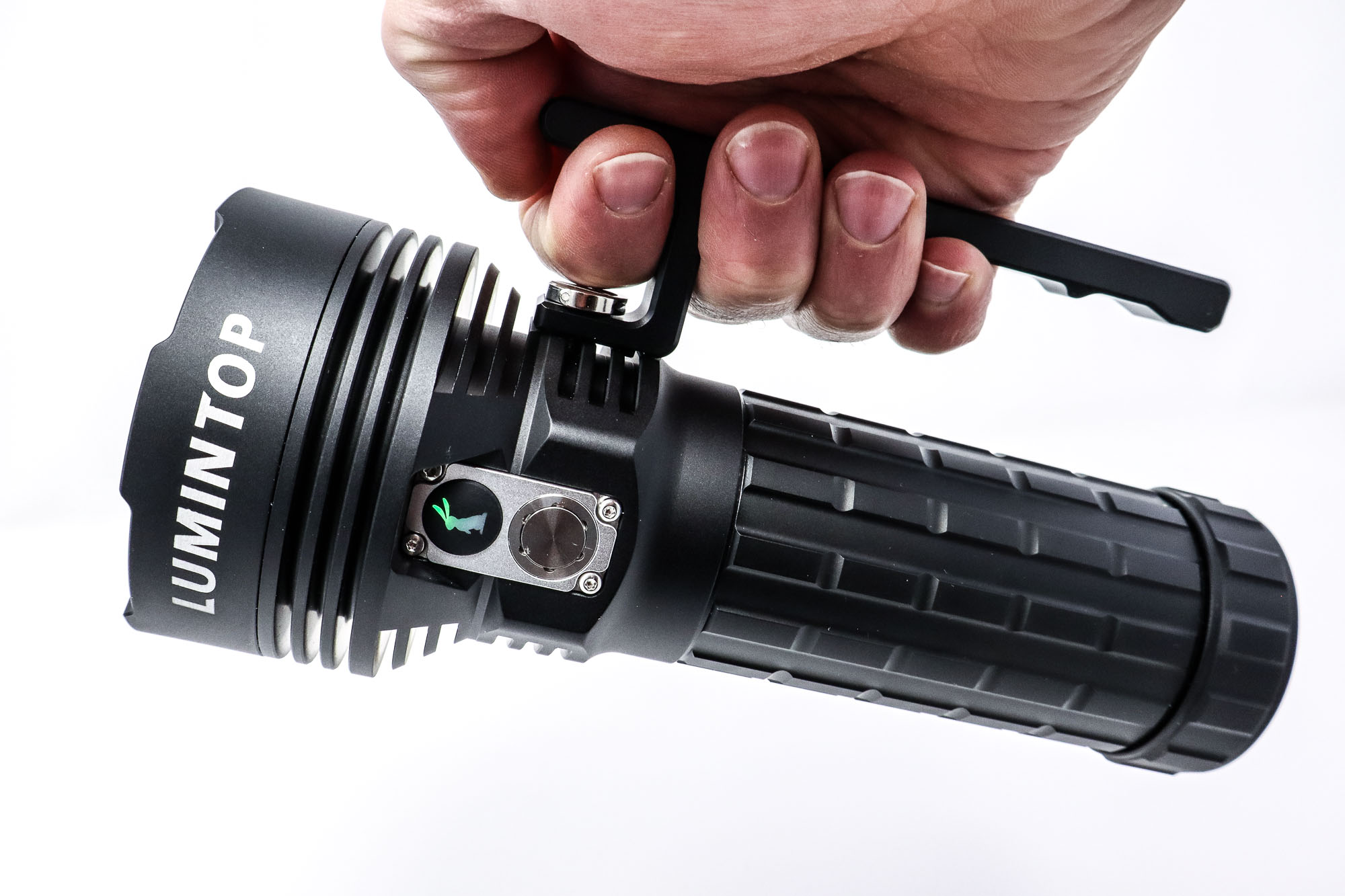
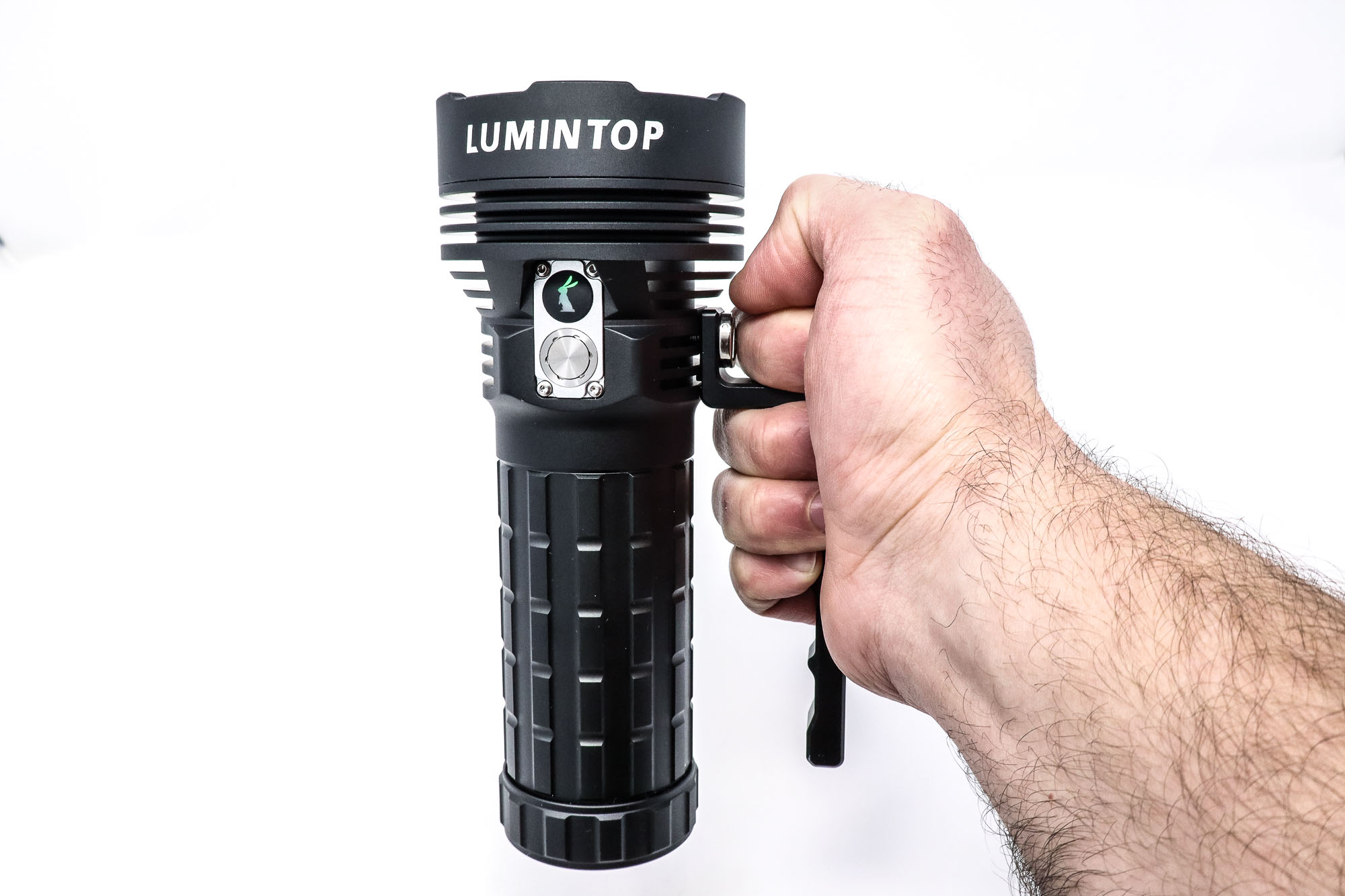
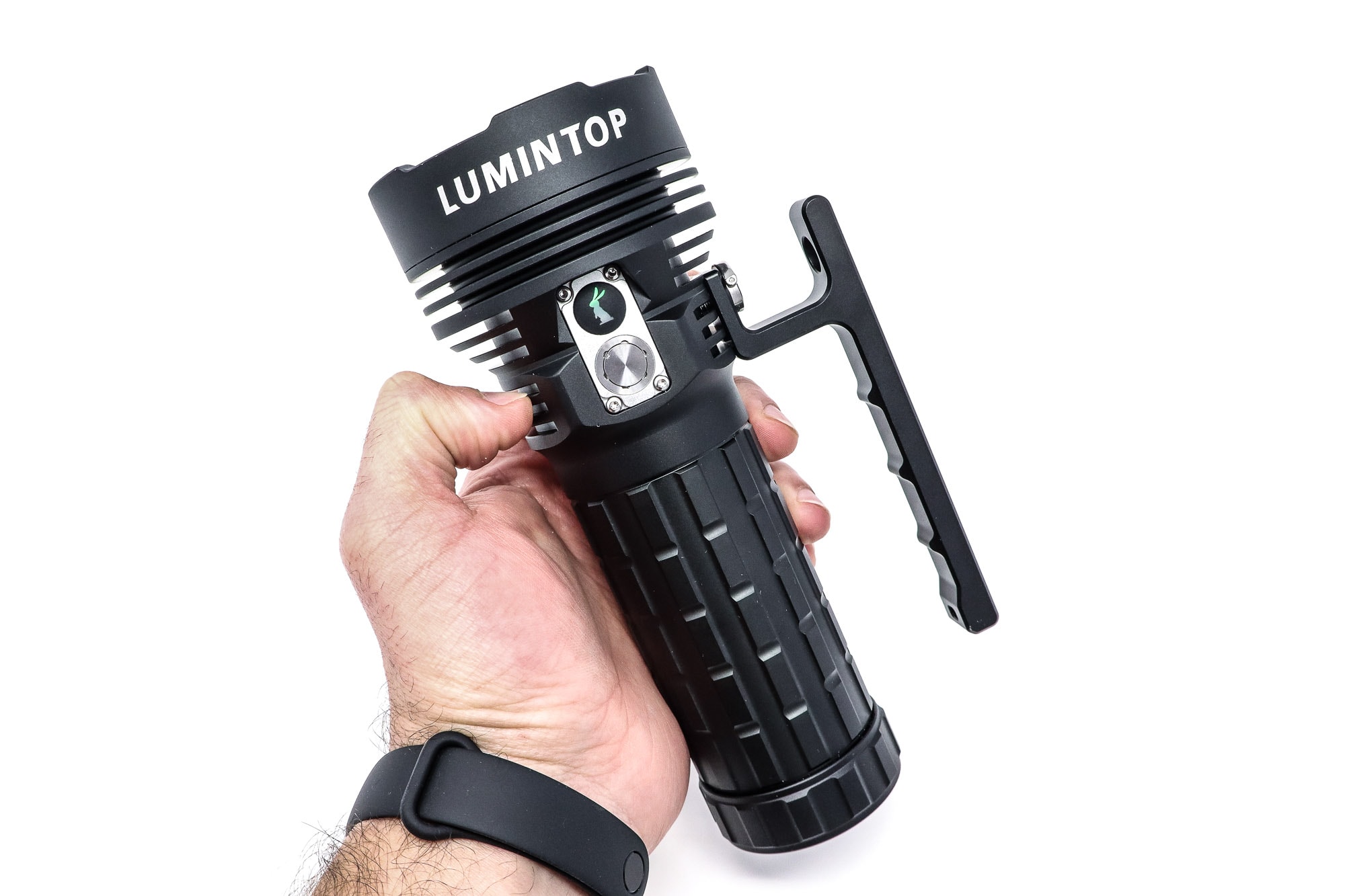
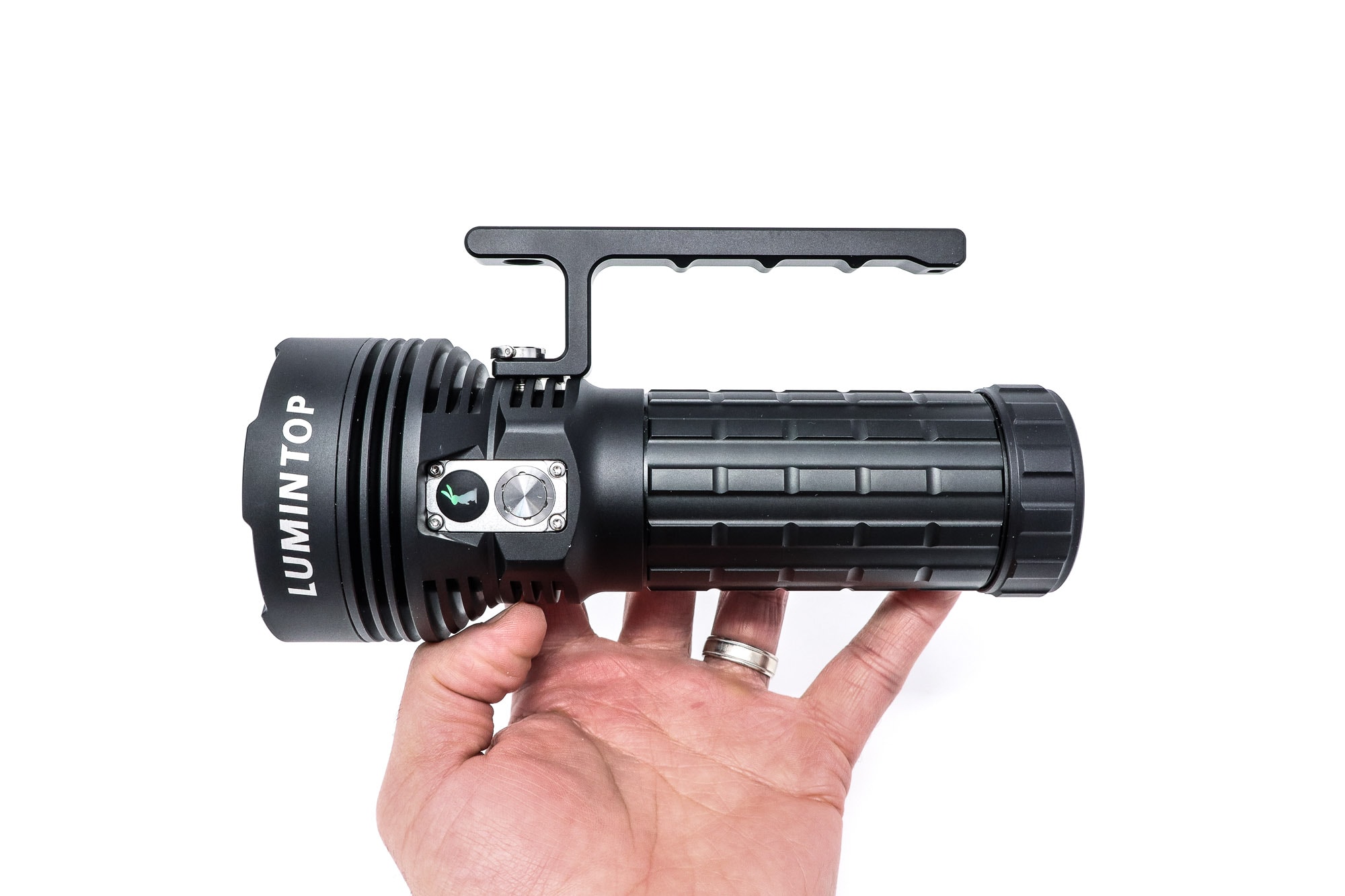
LED, Lens, Bezel, Beam, and Reflector
The business-end of the Lumintop DF11 looks pretty similar to a lot of the other dual-output flashlights that are out there. The combination reflector has a larger center opening for the spot LED and there is a ring of smaller openings around the perimeter for the flood LEDs. The spot area of the reflector is smooth, while the flood reflectors have an orange-peel texture.
Lumintop went with a Luminus SFT40 LED for the spot, which is a pretty good choice. This domeless LED is very resilient, has high output (for a 3V LED), and throws an intense beam. The flood LEDs, of which there are 10, are not named explicitly by Lumintop. They look a lot like Cree XHP70.3 HDs, but I doubt they are. I’m sure if Lumintop was going to splurge on expensive LEDs like that, they would have told us. Secondly, XHP70.3 LEDs are 6V/12V and the SFT40 is 3V. While it would technically be possible to power those at the same time, it would be more complicated than running all 3V LEDs.
The beam produced by the flood LEDs is an absolute wall of light, for a moment at least. That might be good for blinding a would-be attacker for just long enough to use the DF11 as a blunt object. The throw beam does an admiral job, considering that this is an LED (not an LEP) and the central reflector isn’t all that deep (specs say 30mm).
Spectral measurements:
I used the Opple Light Master to measure the flashlight at 5 meters distance.
| Mode: | CCT: | CRI Ra: | duv |
|---|---|---|---|
| Turbo, Combo | 6391 K | 69.2 | +0.0051 |
| Turbo, Flood | 5677 K | 66.6 | +0.0085 |
| Turbo, Spot | 7062 K | 70.0 | +0.0015 |
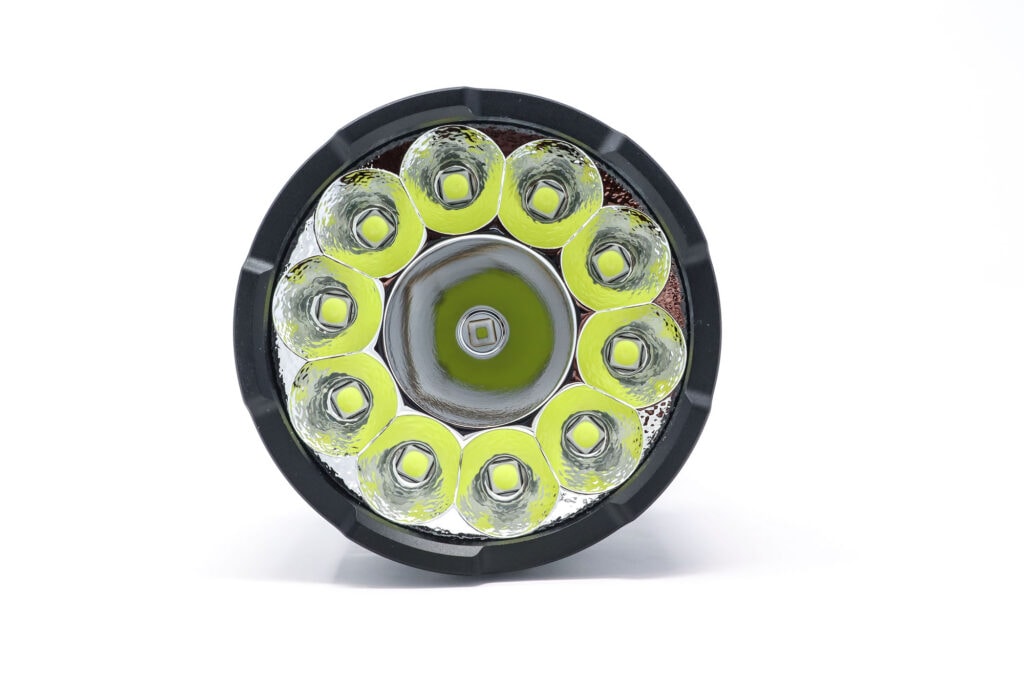

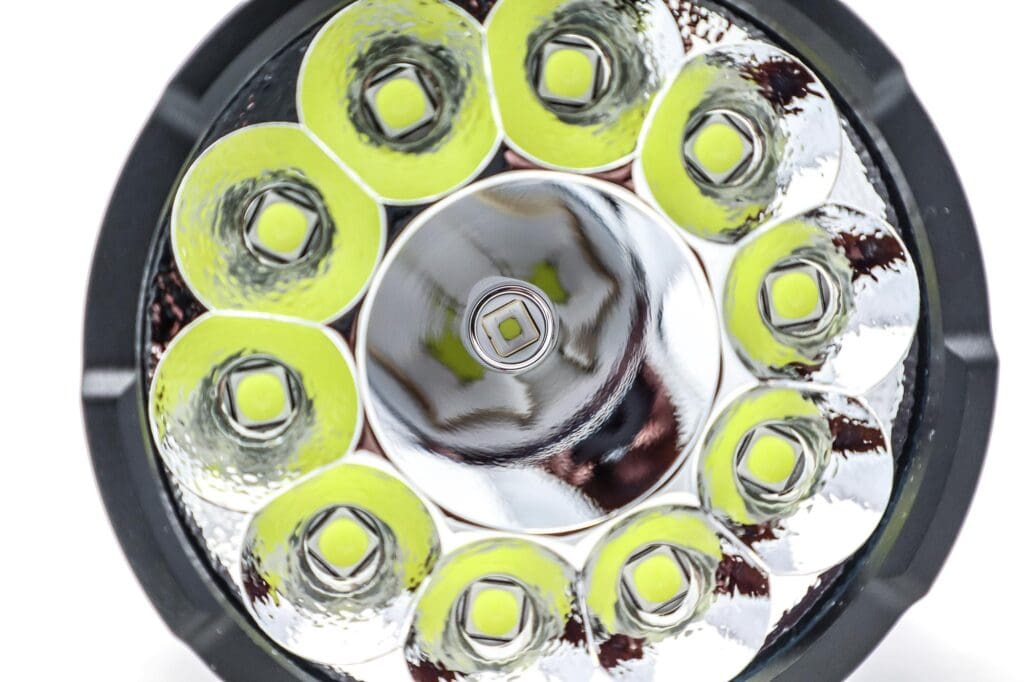
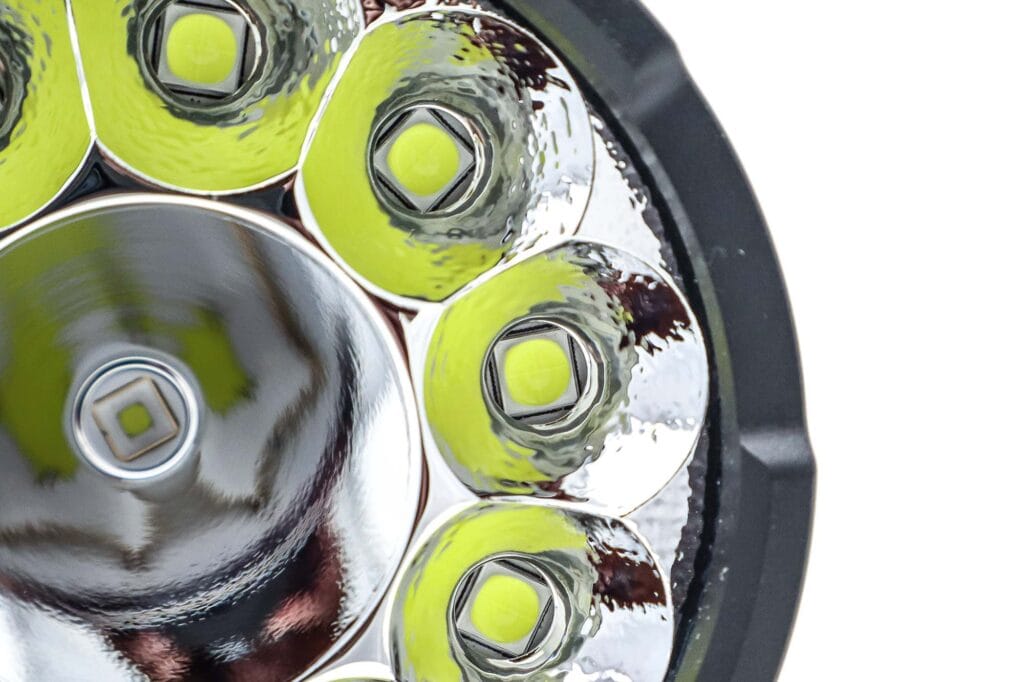
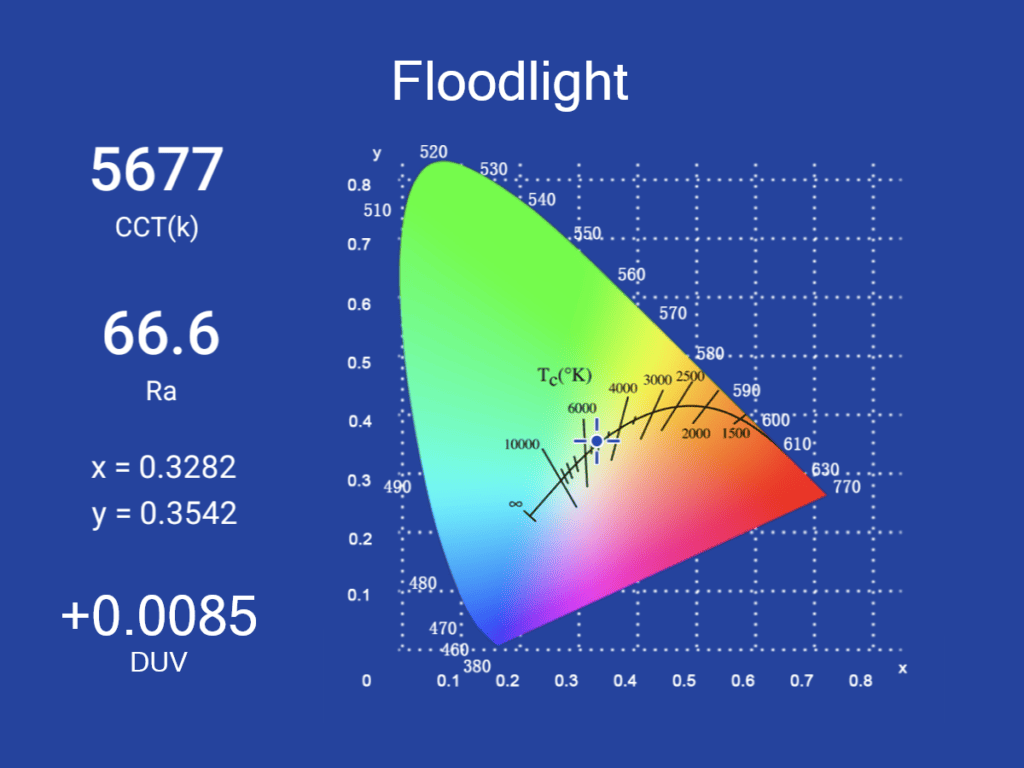
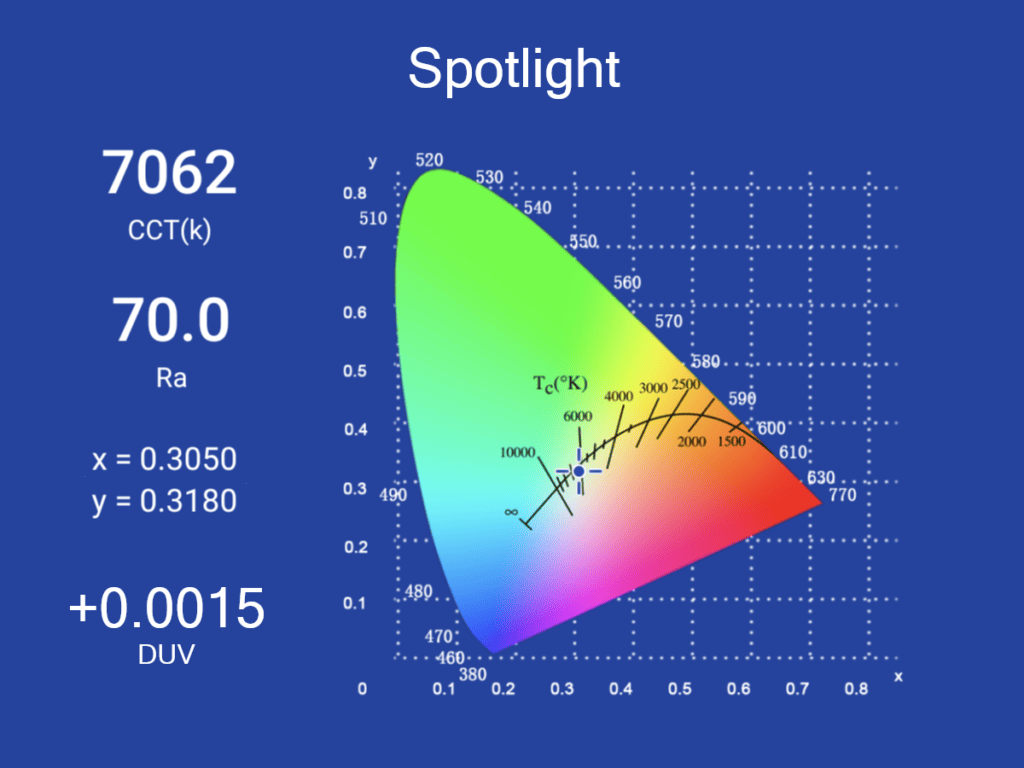
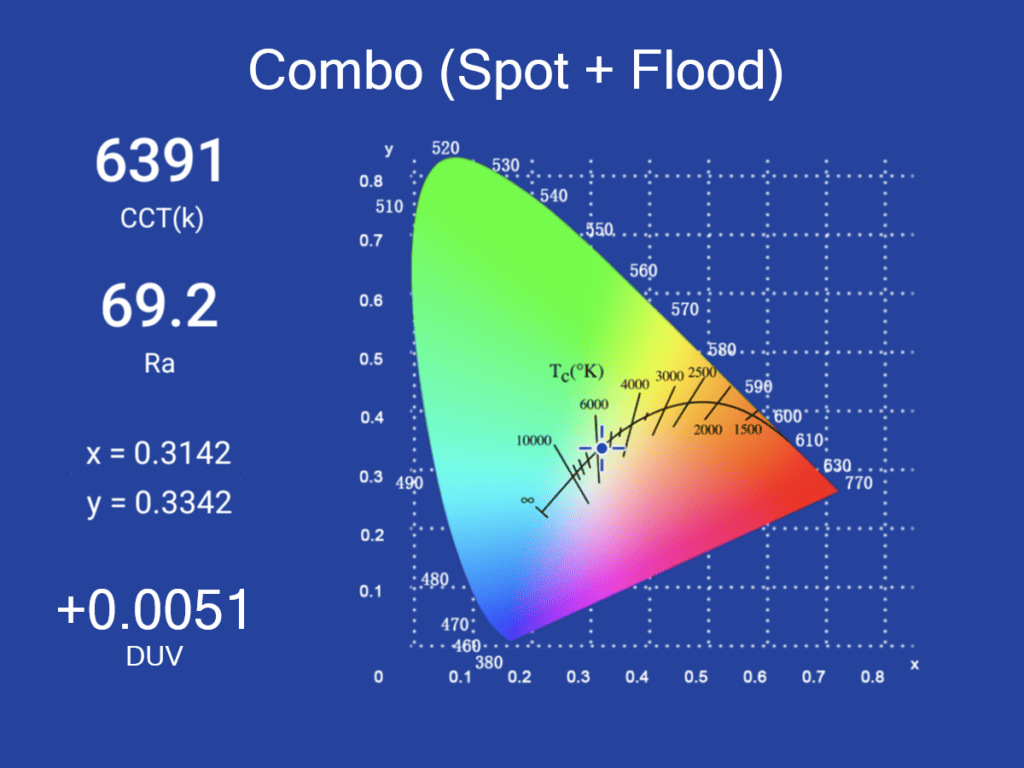
Dimensions and its competition
Dimensions:
| Lumintop DF11 | Millimeters | Inches |
|---|---|---|
| Length | 195 mm | 7.7 in |
| Head diameter | 77 mm | 3.0 in |
| Body diameter | 51 mm | 2.0 in |
Dimensions are rounded to the nearest millimeter and the nearest tenth of an Inch.
Weight:
| Lumintop DF11 | Weight in grams | Weight in oz |
|---|---|---|
| With handle | 1069 g | 37.7 oz |
| Without handle | 1124 g | 39.6 oz |
Weight is rounded to the nearest gram and tenth of an Oz.
Flashlight size comparison with its competition:
Group 1: Astrolux EC01X, Lumintop DF11, Fenix LR40R V2.0
Group 2: Mateminco MT35 Mini, Lumintop DF11, Acebeam E75
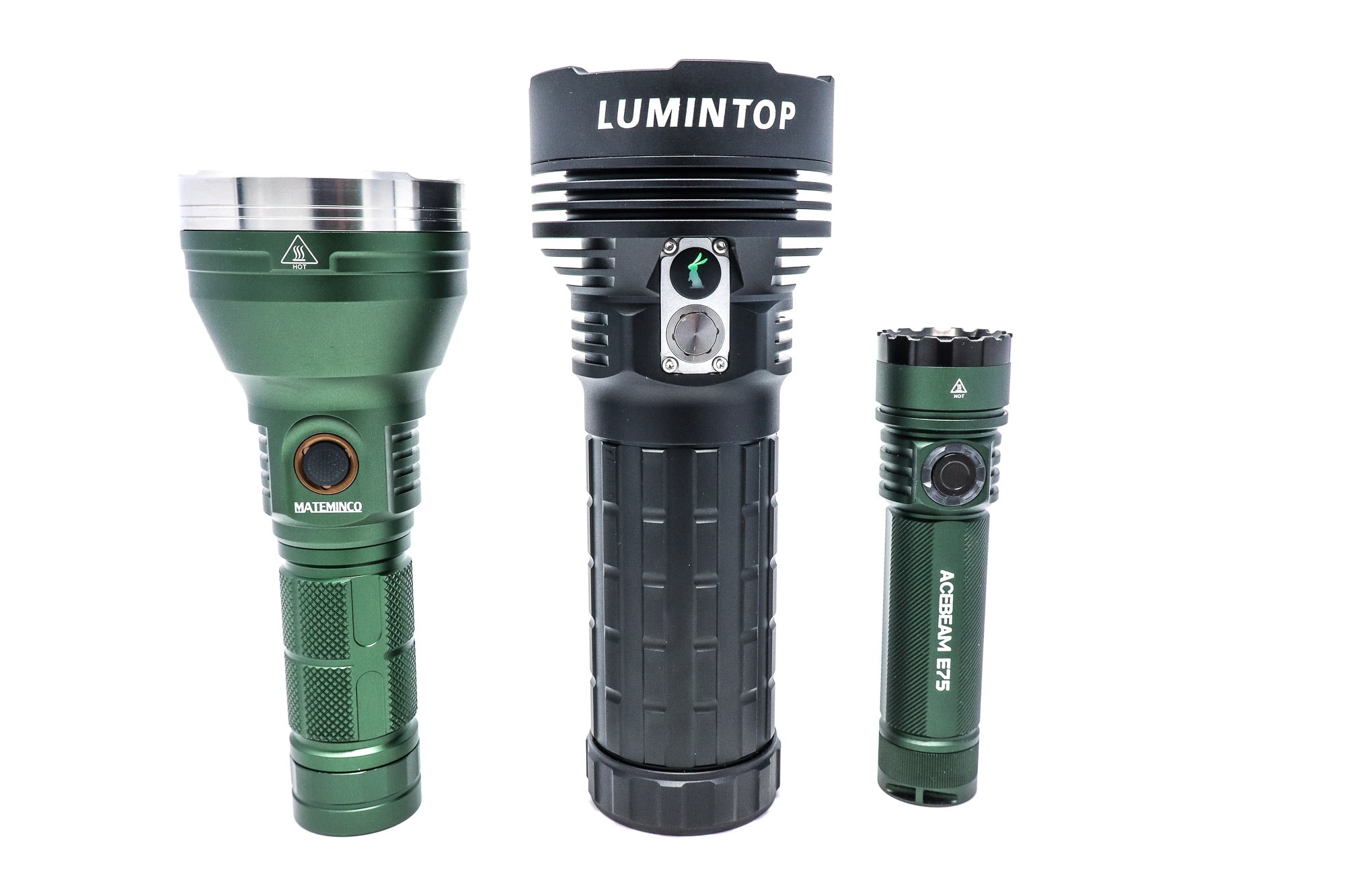
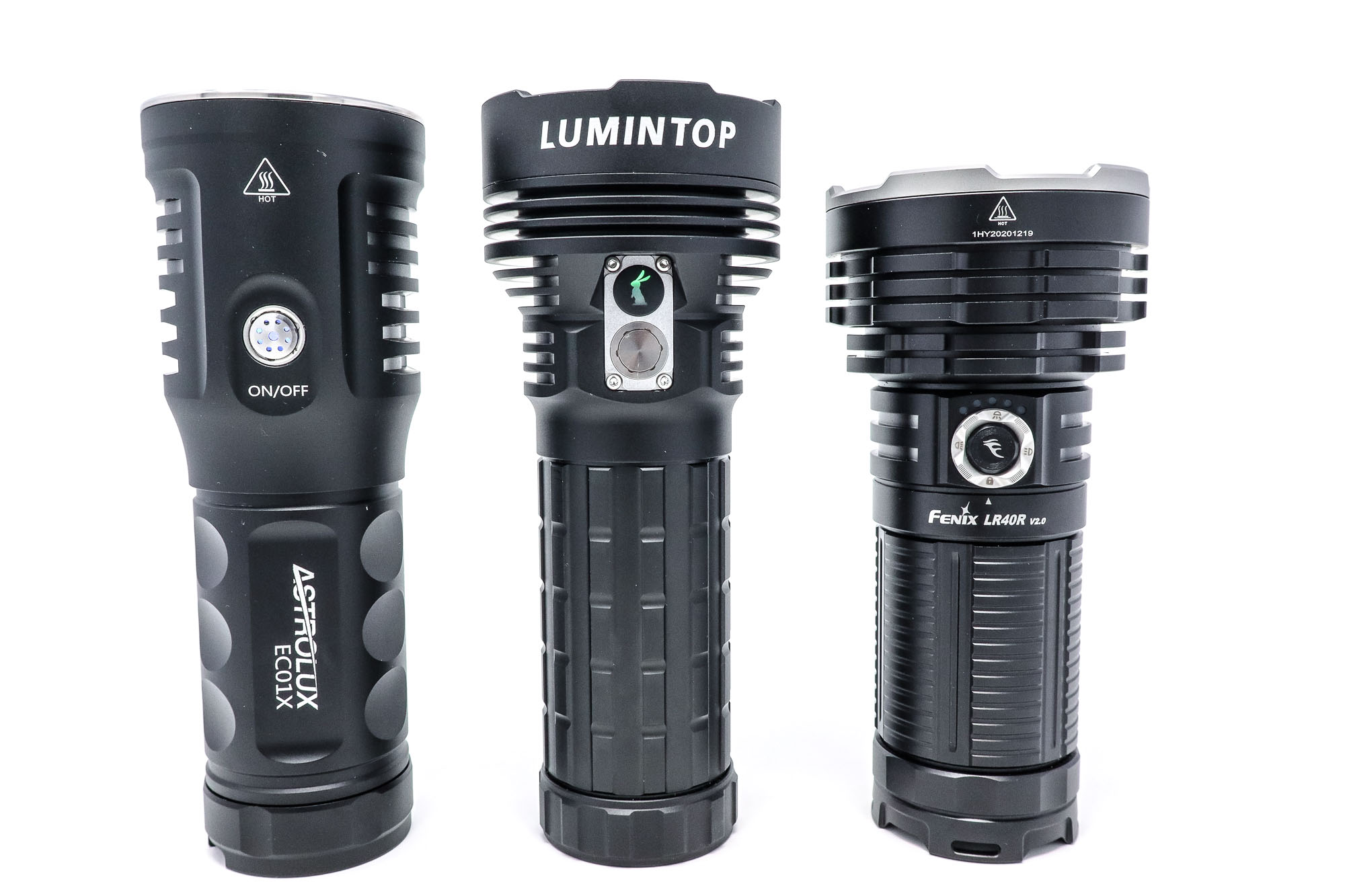
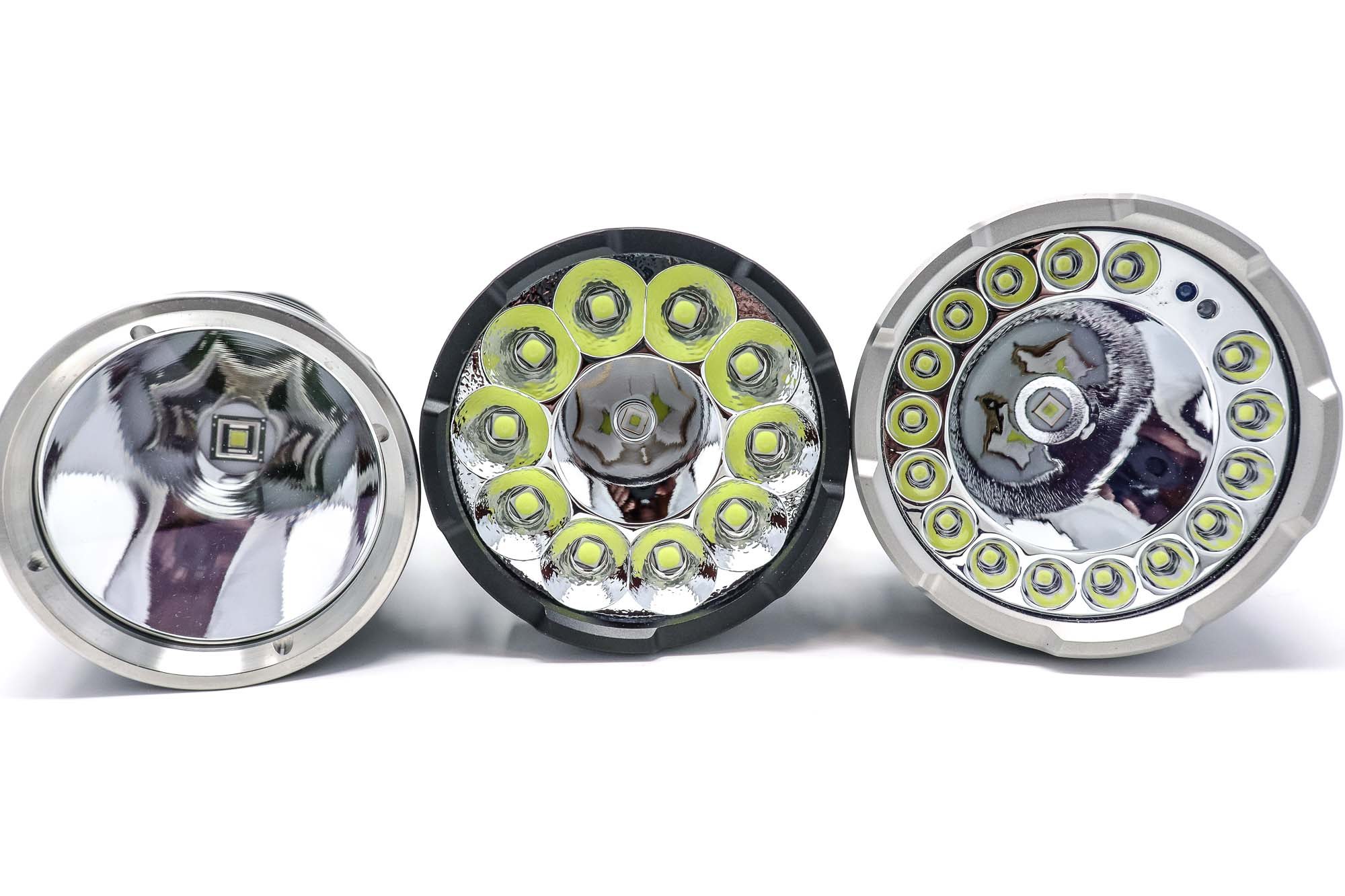
Lumintop DF11 UI: User Interface and Driver
As far as some dual-output flashlights go, the Lumintop DF11 is pretty easy to operate. It’s a big help that there is a distinct button for switching light sources, and that’s all it’s used for. And the indicator LEDs under the main switch constantly remind you which light source is active (or will be active once the light is turned on).
There is one thing that throws me for a loop with the UI, and once you understand why it happens, I suppose you would get used to it. When the DF11 is on, click and holding the main switch causes it to ramp up through Low > Med > High and back around. But if you release the switch and do that again, it’ll traverse the modes in reverse order. That behavior isn’t new – Anduril and some other UIs do that. But with Anduril, you have to try ramping again right away, like less than a second, otherwise it just ramps up like usual. With the Lumintop DF11, you have a lot longer of a window in which to have paused before ramping again where it will ramp in reverse order.
Available modes:
- Eco, Low, Med, High, Turbo
- Each of those 5 modes is available in Spotlight, Floodlight, and Combo – for a total of 15 different outputs
Available blinky modes:
- Strobe, Beacon, and SOS
- Each of these 3 blinky modes is also available in each channel, so 9 different possibilities
Light Source Switch – instead of describing these functions within the rest of the UI, I’ll call them out here:
- Single click (whether Off or On): switch between Flood and Spot
- Double click: activate Combo
From OFF:
- Press and hold: Eco
- Single click: turn On
- Double click: Turbo
- 3 fast clicks: Battery Check
- 4 fast clicks: Lockout
- 7 fast clicks: switch backlit light on/off
From ON:
- Press and hold: change mode
- 1 click: turn Off
- Double click: Turbo
- Double click from Eco: Strobe
Mode memory:
- The “normal” modes will be memorized (Low, Med, High)
- Eco, Turbo, and blinking modes will not be memorized
Shortcuts:
- To Eco: press and hold from Off
- To Turbo: double click from Off or On
- To Strobe: double click from Eco
Low voltage warning/protection:
- 3 clicks from Off puts the DF11 in Battery Check mode
- It blinks out similar to how Anduril does: for 3.7V, it will blink 3 times, pause, and blink 7 times
Strobe/blinkies
- To get to Strobe, double click from Eco mode
- To get to SOS, double click from Strobe mode
- To get to Beacon, double click from SOS mode
Lock-out mode:
- 4 fast clicks from Off enables Lockout mode
- 4 more fast clicks unlocks the light
- When locked out, momentary on is available
PWM
- I did not notice PWM with my eye, but my DMM says there is 15.9 kHz PWM
Additional/summary info on the UI:
- Overall, the UI seems good, but not great. There are some nice shorts (Eco, Turbo), but getting to Strobe is strange, if that is something you use much (I don’t, and am personally glad that it’s difficult to get to)
- The reverse ramp timing throws me off a bit
- When you’re in Eco mode, you can’t get to the normal modes (Low, Med, High)… just Strobe
Lumintop DF11 Charging and batteries
The Lumintop DF11 uses a monstrous 46110 lithium-ion battery. At first, I didn’t realize that it’s a built-in battery, since you need to unscrew the battery tube and remove the isolation disc. But yep, the battery is built into the battery tube. It has a stated capacity of 38,000 mAh.
The DF11 has a USB-C port for charging and discharging (powerbank functionality) and supports a bunch of fast charging protocols (QC2.0, QC3.0, PD2.0, PD3.0, PPS… etc). Input voltages of 5V and 9V are supported. And oddly, output voltages are 5V (3.0A), 9V (2.0A), and 12V (1.5A). It seems strange that it would support 12V in but not out, but that lines up with my observations. When charging the DF11, my meter showed 2.10A @ 8.80V for 18.48W and eventually transferred 152Wh.
If you’re going camping or otherwise find yourself in frequent need of a large powerbank, the Lumintop DF11 excels in that arena.
| Charge type | Fits | No fit | Charge time |
|---|---|---|---|
| Flashlight with onboard USB-C | N/A (built-in) | N/A | 8h 36min |
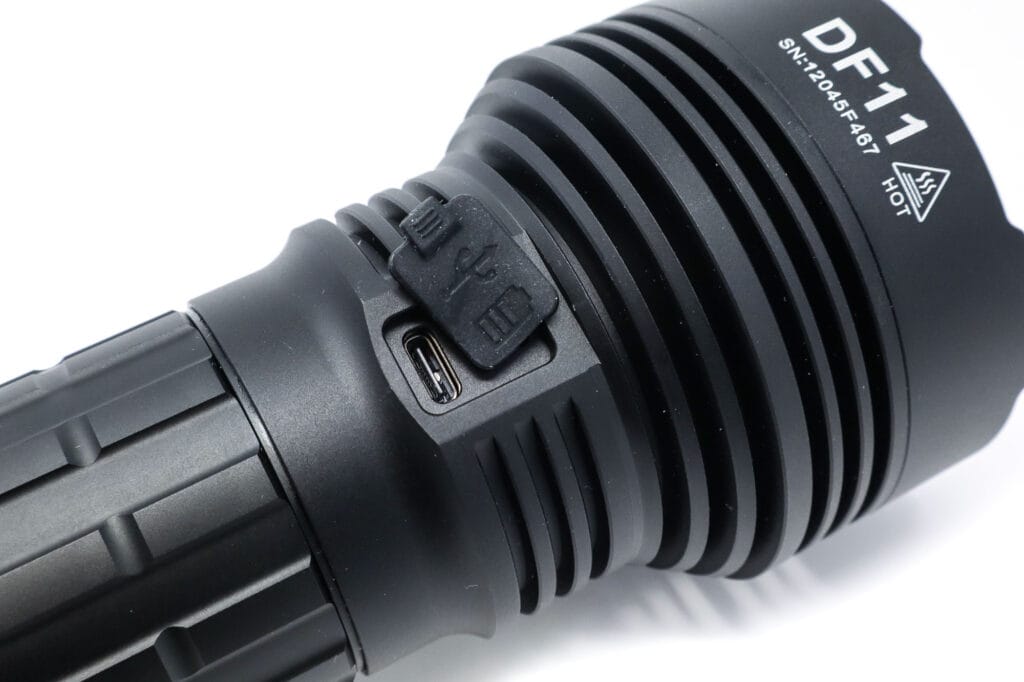
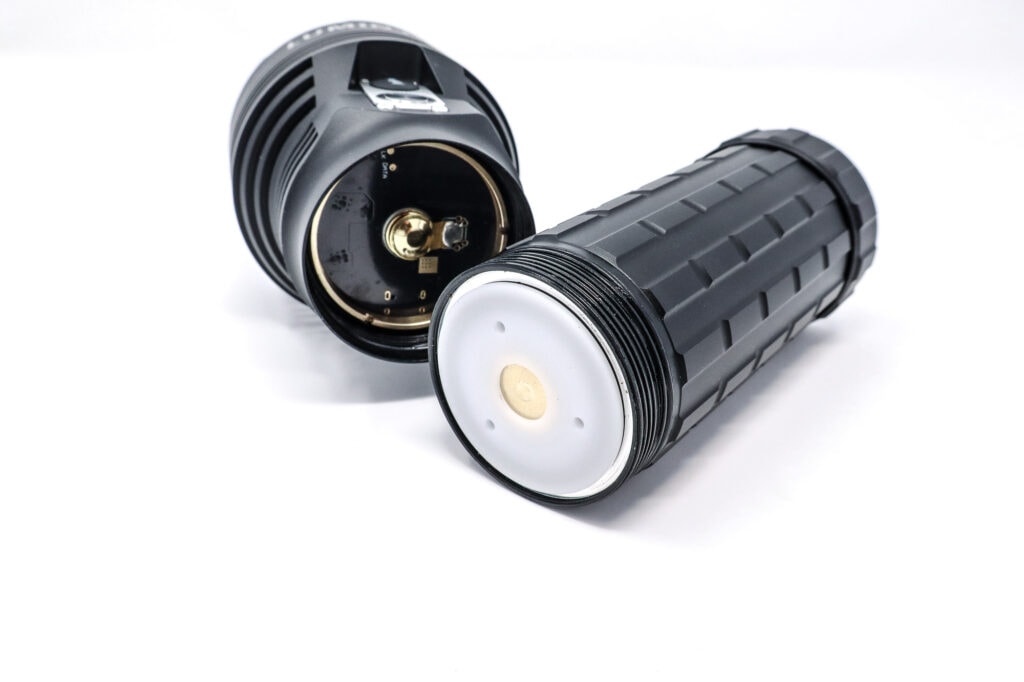
Performance test
Lumen measurements
How Lumens are Measured: Understanding ANSI FL1 Standards How Lumens are Measured: Understanding ANSI FL1 Standards: The ANSI FL1 standards specify that output in lumens should be measured 30 seconds after turning on, as this is the standardized time for measuring brightness according to the industry standard. This is why we focus on this part in our measurements. The ANSI FL1 standards require an ambient temperature of 22 ± 3°C. We record the ambient the ambient temperature to identify potential reasons for any observed discrepancies.Lux was measured by a UNI-T UT383 BT at 5 meters. Lumens were measured in a homemade lumen tube using a VEML7700 sensor, calibrated with a calibration light provided by 1Lumen. The included 46110 battery was used in the tests.
Combo (Spotlight + Floodlight)
| Mode | Specified | Turn on | 30 sec. | 10 min. |
|---|---|---|---|---|
| Eco | 40 lm | 45 | 45 | – |
| Low | 400 lm | 320 | 320 | – |
| Med | 2,000 lm | 1339 | 1337 | – |
| High | 11,000 lm | 7,674 | 7,659 | 1,334 |
| Turbo | 26,000 lm | 22,562 | 19,806 | 1,332 |
Floodlight
| Mode | Specified | Turn on | 30 sec. | 10 min. |
|---|---|---|---|---|
| Eco | 20 lm | 18 | 18 | – |
| Low | 300 lm | 255 | 255 | – |
| Med | 1,800 lm | 1339 | 1338 | – |
| High | 10,000 lm | 6,949 | 1,336 | 1,334 |
| Turbo | 25,000 lm | 20,160 | 19,958 | 1,329 |
Spotlight
| Mode | Specified | Turn on | 30 sec. | 10 min. |
|---|---|---|---|---|
| Eco | 20 lm | 27 | 27 | – |
| Low | 100 lm | 79 | 79 | – |
| Med | 350 lm | 833 | 822 | – |
| High | 1,000 lm | 850 | 839 | 801 |
| Turbo | 1,600 lm | 2,550 | 2,272 | 1,462 |
Ambient temperature during testing:
- 21 °C
Parasitic drain:
- Couldn’t measure due to built-in battery
The Lumintop DF11 is crazy bright… for about 30 seconds. I couldn’t get it to hit spec, though, falling about 13% short. And I get it that Turbo is turbo after all – it’s meant to be used in short bursts. But even High steps down in 20-30 seconds, effectively topping the DF11 out at 1300 lumens after 30 seconds in any mode. To me, that’s just a shame for such a big (>1kg) and powerful light. It doesn’t seem like the initial drop is done because of high temperatures, because the head of the flashlight is around 35°C when the huge step-down happens.
Lumintop DF11 Battery Life: Runtime graphs
How Runtimes are Measured: Understanding ANSI FL1 Standards About ANSI FL1 runtime standards: The runtime is measured until the light drops to 10% of its initial output (30 seconds after turning on). This does not mean that the flashlight is not usable anymore. The last column shows how long the light actually works till it shuts off. If there is a + symbol, it means that the test was stopped at that particular point, but the light was actually still running. This happens on certain occasions, with certain drivers, firmware, or batteries.Combo (Spotlight + Floodlight)
| Mode | Specified | Runtime (ANSI FL1) | Time till shut off |
|---|---|---|---|
| Eco | 12d | – | – |
| Low | 40h | – | – |
| Med | 8h 10min | – | – |
| High | 60s + 8h | 9h 15min | 9h 28min+ |
| Turbo | 20s + 8h | 44s | 19h 37min+ |
Floodlight
| Mode | Specified | Runtime (ANSI FL1) | Time till shut off |
|---|---|---|---|
| Eco | 24d | – | – |
| Low | 50h | – | – |
| Med | 9h 30min | – | – |
| High | 60s + 9h | 5h 33min+ | 5h 33min+ |
| Turbo | 20s + 9h | 46s | 28h 58min+ |
Spotlight
| Mode | Specified | Runtime (ANSI FL1) | Time till shut off |
|---|---|---|---|
| Eco | 24d | – | – |
| Low | 100h | – | – |
| Med | 30h | – | – |
| High | 10h 10min | 10h 7min+ | 10h 7min+ |
| Turbo | 30s + 10h | 12h 18min | 26h 6min+ |
What can I meaningfully say about the runtime of the Lumintop DF11? Two things jump to mind: since Turbo drops like a rock, the ANSI runtime can be quite short. Secondly, this thing can run forever. Since it drops down to around 1300 lumens within the first minute and it has a massive 38,000 mAh battery, it’s going to run at that low output for hours upon hours. Which is good if you need a medium output light for a long time, like when camping. I will say, though, that trying to do runtime tests was really tiring with the DF11 as a test could run for 29+ hours and still keep chugging, and then need another 8+ hours to recharge.
After letting the Combo/Turbo runtime test go to almost 20 hours, the battery voltage was still at 3.05V – well above the danger zone. The flashlight would likely have run for many more hours at the low output.
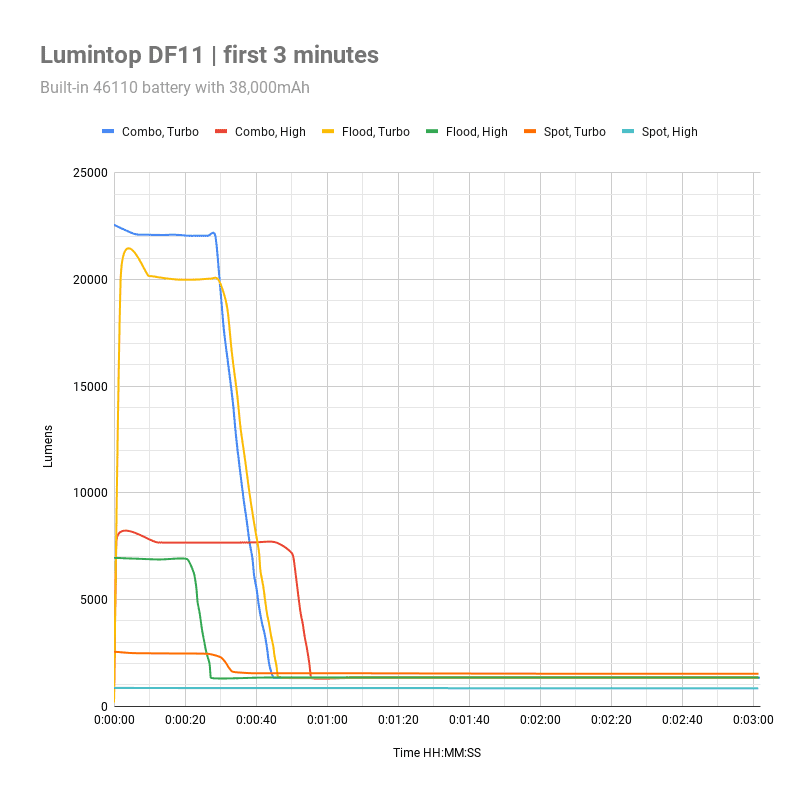
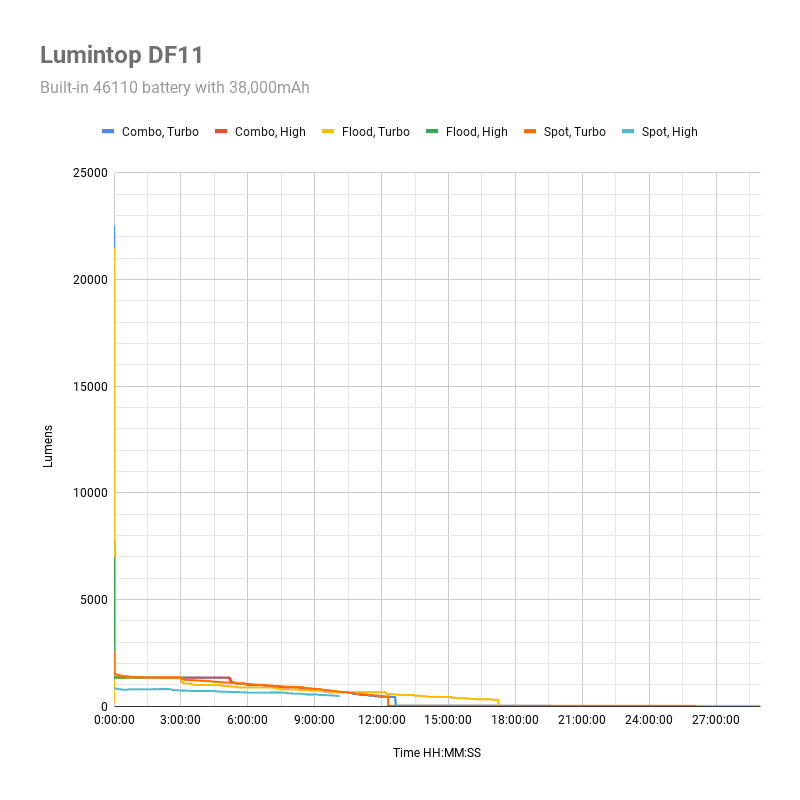
Peak beam intensity and beam distance measurements
About Peak beam intensity: Understanding ANSI FL1 Standards About peak beam intensity The calculated value of distance in meters at which the flashlight produces a light intensity of 0.25 lux. (0.25 lux is about the brightness of a full moon shining on an object). This means that the intensity has decreased so much, it becomes difficult to see darker objects, or objects that don’t reflect light. The columns ‘Meters’ and ‘Yards’ use rounded numbers.Intensity was measured at 5 meters after being turned on for 30 seconds. A UNI-T UT383 BT lux meter was used.
Combo (Spotlight + Floodlight)
| Mode | Specified | Candela measured | Meters | Yards |
|---|---|---|---|---|
| Low | – | 220 cd | 148 m | 162 yd |
| Medium | – | 857 cd | 293 m | 320 yd |
| High | – | 1,816 cd | 426 m | 466 yd |
| Turbo @ 0s | 145,000 cd | 137,425 cd | 741 m | 811 yd |
| Turbo @ 30s | – | 120,675 cd | 695 m | 760 yd |
Floodlight
| Mode | Specified | Candela measured | Meters | Yards |
|---|---|---|---|---|
| Low | – | 950 cd | 62 m | 67 yd |
| Medium | – | 4,075 cd | 128 m | 140 yd |
| High | – | 22,450 cd | 300 m | 328 yd |
| Turbo @ 0s | 75,750 cd | 53,725 cd | 464 m | 507 yd |
| Turbo @ 30s | – | 48,350 cd | 440 m | 481 yd |
Spotlight
| Mode | Specified | Candela measured | Meters | Yards |
|---|---|---|---|---|
| Low | – | 5,675 cd | 151 m | 165 yd |
| Medium | – | 23,975 cd | 310 m | 339 yd |
| High | – | 72,950 cd | 540 m | 591 yd |
| Turbo @ 0s | 90,000 cd | 111,550 cd | 668 m | 731 yd |
| Turbo @ 30s | – | 99,450 cd | 631 m | 690 yd |
Ambient temperature:
- 21 °C
The intensity measurements at least came pretty close to spec, as long as we’re talking about Max / Turn On values, which is what Lumintop includes on their spec sheet. I actually measured the Spotlight intensity to be above spec – a pleasant surprise.
Beamshots
Camera settings and distance: Beam shots of the building are taken at 30 m (33 yd) using a Canon EOS R100 with a lens set to 18mm. Manual settings: ISO 800, 1/4sec, F4.5, 5000K.
Beamshots of the following flashlights compared:
- Lumintop DF11 – Combo
- Lumintop DF11 – Flood
- Lumintop DF11 – Spot
- Nitecore EDC33 – Search
- Nitecore EDC33 – LuminShield™
Please note that the following beamshots are mainly intended to showcase the beam pattern and beam quality, rather than overall performance. These images are typically taken directly after activation, and in different seasons or weather conditions, and therefore do not fully represent its overall performance. For accurate performance metrics, such as output, beam distance, and runtimes, you need to look at the performance section of this review.
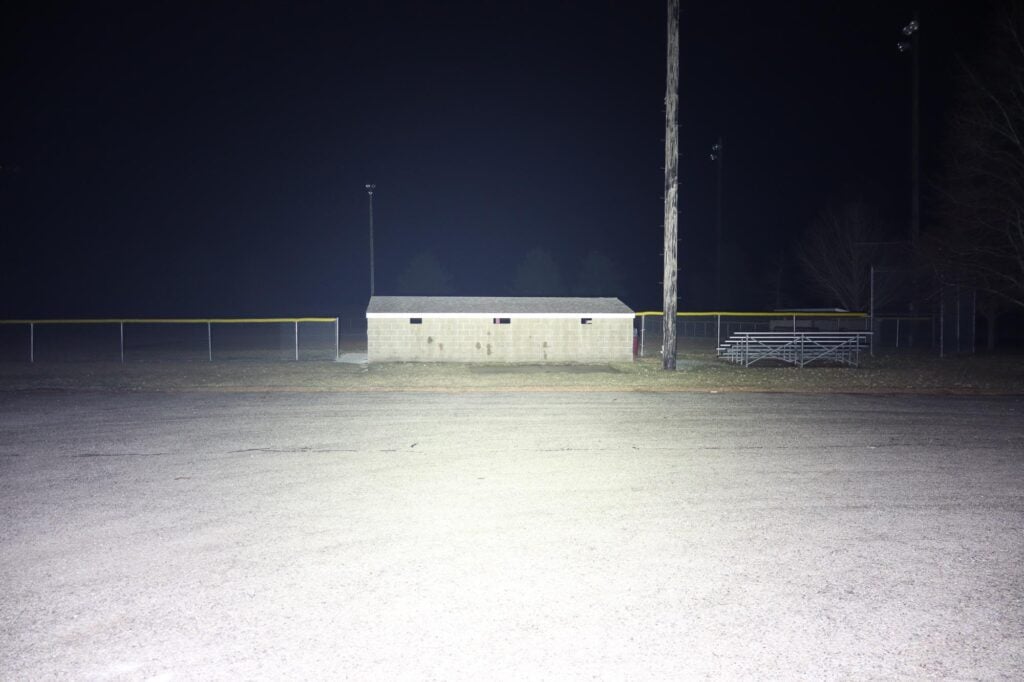
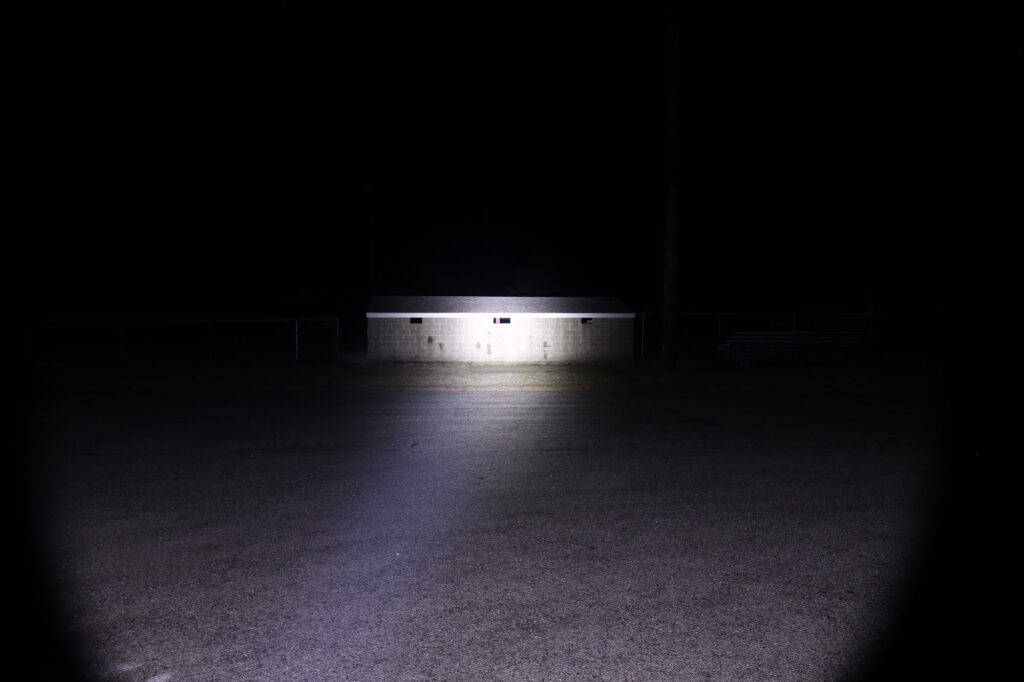
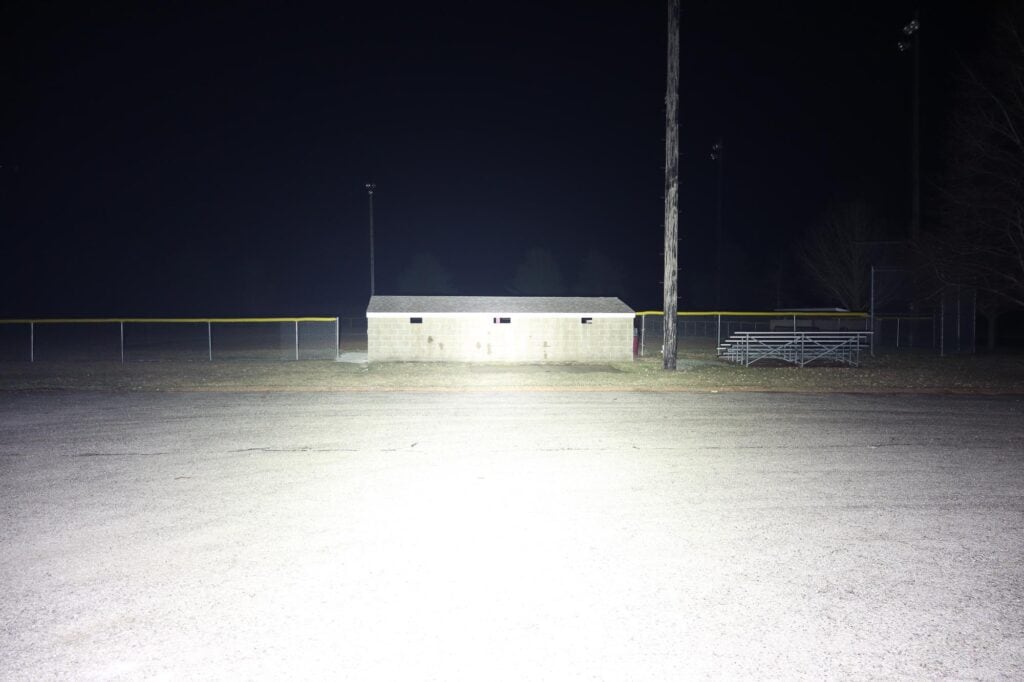

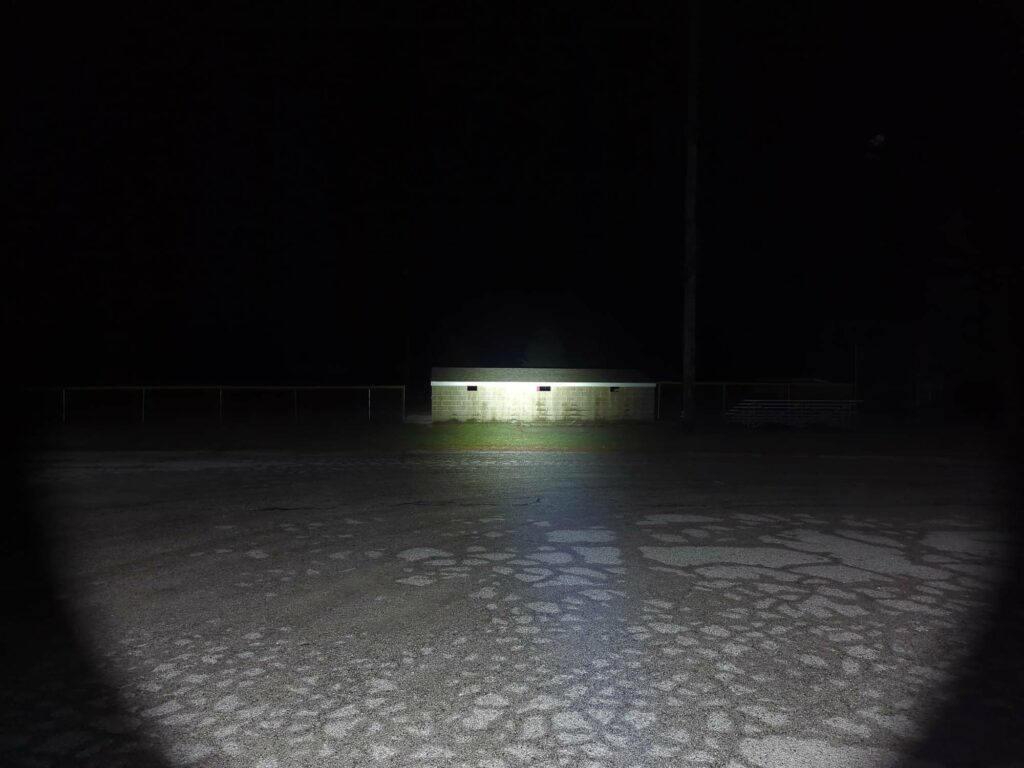
Disclaimer: This flashlight was sent to us for review at no cost by Lumintop. We have not been paid to review, nor have we been holding back on problems or defects.
Final Verdict
Pros
- Solid build quality
- USB-C charging
- Powerbank functionality
- Dual-switch UI is fairly easy
- Removable handle is a plus
Cons
- After ~30s, this is a 1300 lm flashlight
- Charging is pretty slow (8+ hours)
- Misses lumen spec
- UI has some quirks (reverse ramp timing, can’t access normal modes from Eco, etc)
Explanation on star ratings:
1: Avoid: a match would be a better choice – 2: Poor: significant defect or issues; almost unusable – 3: Average: some defects or issues; but still usable 4: Good: recommended (minor issues) – 5: Great: highly recommended

4 stars: ★★★★
While our star rating provides a reliable indicator, we encourage you to read the full review to make an informed decision based on your own needs and preferences.
The Lumintop DF11 has a lot of potential. I feel like all of the physical aspects are there: big, beefy build with a monstrous battery, nice switches, and LEDs that are capable of pumping out a lot of lumens. But all of this seems to be for a quick burst of excitement before becoming a 1300 lumen flashlight after ~30 seconds.
So if you need a bright flashlight, the DF11 sadly isn’t for you – despite its 26,000 lumen claim. If, on the other hand, you’re a collector or just want to show off occasionally, then by all means – check out the Lumintop DF11. It certainly is fun in short bursts. If only the firmware had proper thermal regulation or something along those lines, this flashlight would be easier to recommend.
Buy your Lumintop DF11 with a discount
Get 10% off at Lumintop Online by using our exclusive discount coupon code: 1lumen
1lumen selects and reviews products personally. We may earn affiliate commissions through our links, which help support our testing.